#the first draft of this post was a parody of The Naming of Cats but I couldn't quite get it to work
Text
nominative determinism
05/05/2023 It seemed like a good idea at the time.
When we have chicks, we give them descriptive nicknames based on their transient baby spots and stripes. As they grow up, they earn real names based on their devotion to a particular teaching of the mystic arts of Galline Derangement.


One of the batch of chicks eight months ago was yellow, except for a white face and black marks around the eyes. She looked like she was wearing clown makeup.
I didn't want to nickname her "Clown" or "Mime." I wanted to Be Clever About It. So her hatchling nickname became "Homestuck" because I was on tumblr a decade ago when everyone was posting fanart of Homestuck characters with clown makeup.


Today the chickens were making a terrible racket in the henhouse, and I ran out to investigate, and discovered that one of the hens had gotten inside the henhouse wall somehow and couldn't get out.
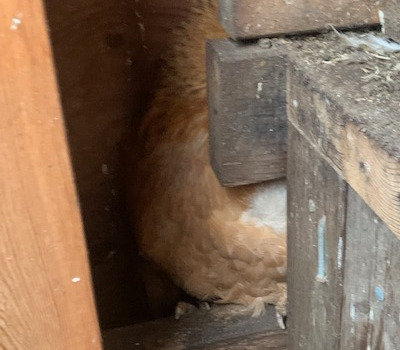
She was, uh, you know. She was... stuck. In her ... home. Guess who it was. Guess.
I got my arm into the wall and tried to support her, which calmed her. I tried lifting her up and out, but there was a crossbeam in the way. I tried guiding her downwards, but she panicked and kicked her feet the instant I wasn't holding her up.
After half an hour of trying to manually thread individual chicken atoms (all of which were screaming) between the wood atoms of the wall, I went to fetch a hacksaw. When I returned, she was standing innocently on the floor of the henhouse, eating a moth she apparently found in the wall.
As she apparently took her hatchling name as a suggestion, she gets to keep it. Presenting the newly christened Homestuck Q. Clipping-Error the Chicken.
#daily#chicken#the vague and polite suggestions of physics#homestuck#a young hen stands in her henhouse#though it was eight months ago she was given life#it is only today she will be given a name#homestuck by osmosis#the first draft of this post was a parody of The Naming of Cats but I couldn't quite get it to work
950 notes
·
View notes
Text
Could Estrogen Have Saved Her (and Her Series?)
The series Sword Art Online is often seen in a negative light by a large internet community. Due to issues with the anime adaptation as well as internet personalities backing hate bandwagons, the series as well as the characters are often flanderized and seen in a way that to fans of the series would seem more like parody than reality. However, there is also a large and vocal group of fans that adore the series, and within that group, a devoted sect that discusses the possibility that Kazuto “Kirito” Kirigaya is a transgender female.
While this essay is not an attempt to claim that Kirito is infact textually transgender, various comments made on posts referencing this idea have had a similar sentiment: “If Kirito was transgender, it would have fixed the series for me”. If you look at a variety of comments and reposts on tumblr posts by niche vtuber HeyGuysItsBeth, this is a common opinion. So, would Kirito being transgender make a noticeable and positive impact on the story of Sword Art Online?
Now there are various moments in the series that support the concept of Kirito being transfem, such as their appearance and the role they play within the Phantom Bullet arc, but the pieces are laid out immediately in the first drafts of the web novel, where Kirito is described as seeing no masculinity in their own face. But let us begin with volume 2 of the manga, in which we meet the character Silica. Silica is a young girl in the world of Sword Art Online, a loner trapped with nothing but her animal companion Pina, but upon our first meeting of her, Pina tragically is struck down by enemies saving Silica, before Kirito can help her escape from the attackers. Kirito provides Silica with new armor and promises to help her revive Pina, asking nothing in return, as in their words “[Silica] reminds them of their little sister Suguha.” Already, this adds in a lot of interesting information. Firstly, despite supposedly being a male player, Kirito already has female equipment, armor, and clothing ready to give out to Silica, with the light novel referring to them as Kirito’s “leftovers” implying that Kirito has already used them, and is passing them on. Then when it comes to the likeness of Silica and Suguha, we later discover that according to Kirito, them and Suguha used to be mistaken for twin girls, despite the fact Kirito is older and not a blood sibling to Suguha. From this, we can gather that Kirito when looking at Silica and saying she reminds them of Suguha, they are saying that Silica reminds them of themself. From Kirito’s perspective, they have just seen a loner, someone by themselves in a world foreign to them, lose the thing they hold dearest, and ready to give up on themselves before someone else comes in to save them. This is what happened only a few days prior to Kirito, as they were too a loner in this world, before being taken into a guild called the Moonlit Black Cats, and they had lost each and every one of them, including the one they held dearest, Sachi. And they were inconsolable and wanted nothing more than to fall as well, until Klein came to beg them to stay alive. Kirito had lost Sachi, their Moonlit Black Cat, and Silica had lost Pina, named for her real world cat.
Silica and Kirito are clearly narrative parallels through this story, as they talk to eachother and bond during their journey to revive Pina. Kirito had lost their birth parents, and then felt alone and isolated again upon the discovery that they were adopted. Silica was an only child, whose parents were always busy with work, and they were left alone with just their cat. Both Silica and Kirito had no friends in the outside world, and in-game, people just wanted them for their looks and for their unique skills, not their genuine friendship. Kirito saw themself in Silica, and gave them their old armor, and did everything they could to help her revive her fallen friend, the thing Kirito was unable to do for Sachi. Silica ends up being Kirito’s hope during their trip, where they had previously been pessimistic on their relationship with Suguha, Silica is there to comfort them, and insist that Suguha must truly love and care for Kirito, and that they must care for her a lot too. Kirito insists that even though they helped Silica revive Pina, Silica helped them more, as they gave them hope, both in game and in the real world. To them, Silica is what they would be if the world was simply a bit kinder to them, which reveals the depressing core, that even in their greatest fantasy, Kirito cannot imagine their own life without tragedy.
When examining this story through the lens of a transgender Kirito seeing Silica as a version of themself, quite literally in their armor, the story goes from what many would write off as a fanservice harem-bait to one that reveals more of the inner struggles and pain of the characters, but also the hope that still exists, that they still have a future to look forward to where things do get better.
Kirito and Asuna, a ginger haired front-line fighter, eventually get married and settle in a cottage by a lake during their time stuck in Aincrad. It is there that they find and adopt a small girl named Yui, raising her as a daughter. Despite her being fully AI, they love her with all their hearts and truly become family with her. Within the Gameverse series of games, Kirito and Asuna elaborate on Yui further, noting that despite her not being their offspring, Yui notably takes a lot of the features of both Kirito and Asuna, but Asuna claims that she resembles Kirito more. And this is true, if you look at how Kirito looks with long hair in GunGale Online, as well as in real life, there is a strong resemblance there. Yui in the gameverse games also claims that Kirito is the one who cuts her hair and styles it every morning, which is a cute detail. However, it also comes with some questions. Kirito, according to themself, simply cuts their hair so that it is out of their face and not bothersome for fighting. This implies that Kirito doesn’t care for hair, so why would they know how to properly maintain it in others. Kirito’s adoptive parents were not home very frequently, as both worked heavily, and Kirito was often left with the responsibility of their younger sister, Suguha. We can infer that Kirito knows how to do hair because of taking care of Suguha’s. But Suguha also has her hair cut short, why? For kendo, as she practices it in real life as well. Given that both Kirito and Sugu practiced kendo, it could be inferred that Kirito and Sugu both used to have long hair, but upon starting kendo, they had it cut short. After all, they were near identical when they were younger. Within the light novel for the Phantom Bullet Arc, it is written that Kirito acts as if they have already had long hair, knowing how to take care of it, fight with it, and the proper ways to handle it when it is in your way.
In this scenario, it is shown that Kirito is a loving and caring parent, helping their daughter like they used to help their sister and themself. Without taking this angle into account, many viewers may brush off Yui’s addition in SAO as mere trauma-bait, being as soon as she is introduced, she is killed. However, with the addition of Kirito’s past with long hair, and the implication that Kirito is almost living vicariously through Yui’s appearance, it adds to the story of both of them.
Speaking of Kirito’s long hair and girly features, let’s talk crossdressing. While the appearance of Kirito in GunGale Online is often seen as a trap trope, we need to further examine what exactly happens within GunGale, as well as outside of it. In GunGale Online, Kirito is presented with a rare male avatar that is incredibly feminine in nature, to the point that everyone assumes they are female. And thus, Kirito acts accordingly, pretending to be female to everyone, including flirting with men at the bar during the preshow for the Battle of Bullets. They don’t need to do this, they just do for fun. Infact, they seem to have more fun with their feminine appearance and attire, as they are more emotive, bubbly, and even have a distinct shine in their eyes that isn’t present anywhere else. But that is solely Sword Art Online II, in Sword Art Offline II, things escalate even further. Sword Art Offline II is an official mini-series in the blu ray and dvd releases of SAO II that is written by the original author, taking the form of a news / talk show discussing the events of the show. Within it, Kirito is referred to as “a cute girl named Kiriko” frequently. Very very frequently. Sinon alleges that Kirito may be secretly crossdressing in the real world, and that if they have a sister, they very well may be stealing her clothes to dress up in, a statement that Kirito is notably flustered by. Asuna also states that it seems like Kirito is enjoying themselves more as a girl than as a guy, and that she would love to dress her up in a bunch of cute clothes and “make her a proper woman”.
By including all of this information, the appearance of GGO Kirito goes from a borderline problematic trap trope, to just an egg of a trans woman learning they are comfortable and enjoy having a female appearance, and just having a fun time with it.
Within Sword Art Online Alicization, Kirito meets a boy named Eugeo and is struck with an unnerving revelation. Outside of the realization that Kirito may also like men, Kirito also realizes that they have been playing a role for most of their life. Kirito was forced into roleplaying a character in Sword Art Online, needing to assume the “beater” persona in order to help all other beta-testers escape the wrath of other players. They were forced into a hero role by the game’s creator, being chosen to help lead the fight against him, and be the one to ultimately face him at the game’s finale. Kirito had to play the role of hero again, saving those who were trapped in Alfheim after SAO shut down. Then, they needed to play hero again, saving people from DeathGun, while also needing to pretend to be a girl to everyone around them. But then they met Eugeo, and saw an actual hero. To Kirito, Eugeo was a hero, with a set goal of making the world better, and truly had the ambition and strength to make it reality. Kirito had been forced into strength, Eugeo was made for it. But Eugeo died in Kirito’s arms, leaving them broken. Someone so much stronger, so much better than them. They couldn’t live. How could Kirito, someone who was simply playing a role, manage to live when Eugeo couldn’t? But it was Eugeo who taught them how to be a real hero, not just a roleplay. And not just a copy of Eugeo, but a hero in their own way. Kirito took up Eugeo’s sword and helped save the Underworld, and brought peace between the realms. They had learned to stop playing a role for the world around them, and to fight as themself instead, and that is what gave them their strength.
In the end, is Kirito transgender? Well based upon the fact Sword Art Offline affirms that Kirito has a chosen female name with Kiriko, enjoys dressing as a girl, and enjoys acting like a girl, yes. But does it matter? Also yes. By examining the narratives present within Sword Art Online, the added characterization and motivations do genuinely provide more impact than just adding in representation. They add more heart and reasoning behind each small story. So yes, transition could have saved her.
#sao#sword art online#i have not written a proper essay in years i am sorry#trans kirito#trans headcanon
21 notes
·
View notes
Text
Comics, art, and non-canon extras for "ENNEAD" by Mojito
There are a number non-canon side comics and extras that Mojito has put out for her boy's love manhwa ENNEAD. Some are available in the official release online and in the physical edition of season 1, and others are only available via Mojito's twitter. I'll summarize about them and link to what I can below. If you'd like to read the manhwa, I have a Tumblr post and carrd for how to do that.
Seth and Anubis hiding from Nephthys
This is seemingly the only canon side comic, and relates to Anubis' character interview (discussed below). Seth and Anubis hide from Nephthys around Heliopolis, and fall asleep. It's available in full in Korean on Mojito's postype (scroll down past the Anubis interview). It was also included in the Korean and Taiwanese print editions of season 1.
Character Interviews/Question & Answer
Mojito did a series of interviews/Question & Answers for the ENNEAD cast based on reader survey questions from August 24, 2020-September 27th, 2020 through WitchComics' twitter and the Naver website. Seth, Horus, Osiris, Isis, Nephthys, and demigod Anubis were all "interviewed" for this. Part of Seth's interview is available in Korean on Mojito's postype, along with part of Anubis' interview. These were included in the Korean and Taiwanese print editions of season 1.
Season 1 Extra non-canon comics
At the end of ENNEAD season 1, Mojito posted two non-canon short story AUs, one for each version of the manhwa. The manhwa has a censored (15/16+) version and an uncensored (18/19+, mature) version. The numbers stand for age ratings. Tiny AU is episode 74 of the censored version, and R19 AU is episodes 74-75 of the uncensored version.
Season 1 Uncensored Version Extra: R19 AU/Dark King Horus AU
The R19 AU (named because the uncensored version is rated for 19+) is about an older draft of the main story where Seth is colder and Horus hates him. After the trial, Horus takes Seth as his prisoner and tortures him.
Season 1 Censored Version Extra: Tiny Seth AU
The Tiny Seth AU has Maat punishing Seth at his sentencing by making him tiny. Horus keeps him as a prisoner and mostly messes around with him (sometimes with Isis joining in).
The Cat with God as Butler
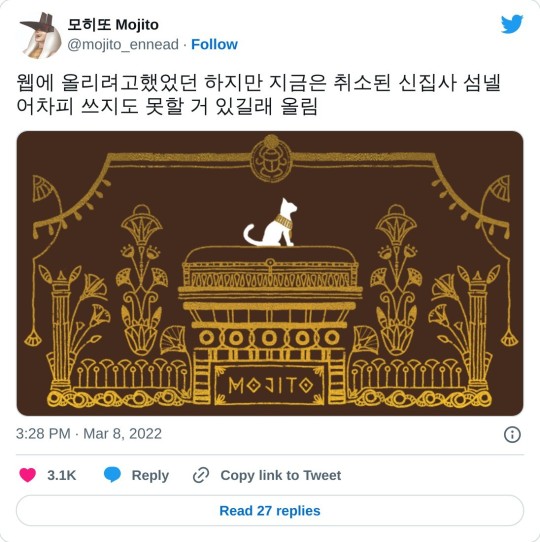
Mojito created a series of non-canon comics featuring Anubis adopting a female cat named Simba, who was also generally adopted by Seth and Nephthys. The comics featured hijinks involving the cat's adventures, mostly with Seth (but also sometimes involving Anubis, Nephthys, Osiris, and Bastet). The first comic is available on Mojito's twitter in Korean. The series was originally published physically around 2017 or earlier, and planned to be re-released in full online, but ultimately cancelled by March 8, 2022. But, Mojito announced on March 18th, 2023, that the complete The Cat with God as Butler would be put out again, seemingly on sale, after completion/full publication of ENNEAD Season 2. Simba has also appeared in the canon on a wall in Khemmis in Season 1, Episode 60.
Art by Mojito of Simba from 2022:

Nephthys/Isis Comic
Mojito released a short comic with Nephthys/Isis on her twitter to commemorate 1.5 million views on ENNEAD.
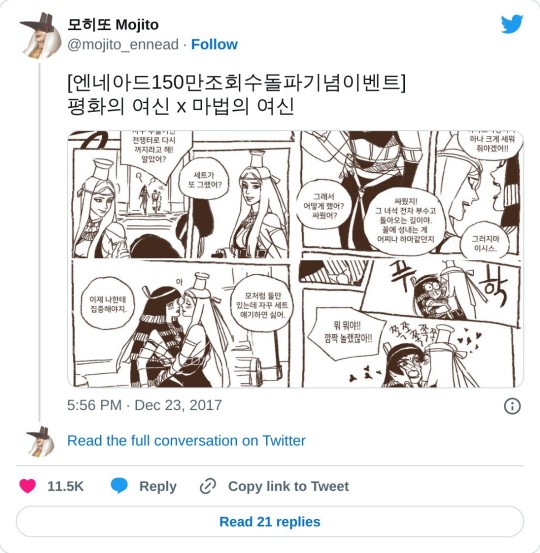
Parody of Sky Castle
Mojito released a two-part comic featuring the ENNEAD cast in a parody of the drama Sky Castle, located in full on Mojito's twitter. (Part 1, Part 2)
Parody of Heungbu and Nolbu
Mojito released a two-part comic featuring the ENNEAD cast in the folktale Heungbu and Nolbu, located in full on Mojito's twitter. (Part 1, Part 2). It was translated into English officially for the first time for the release of volume 2 of ENNEAD in English, with Seven Seas.
Extra Art
Mojito has released a great deal of extra art over the years, for fun or to commemorate events. Most of these are available on her twitter. Some art was made into official merchandise, which you can still buy via Koonbooks, which is an overseas official vendor.
Tarot Card Set
In 2019, Mojito made an ENNEAD tarot set, which was released in limited amounts by Seoul Comics, and has been sporadically released by them over the years as rewards for contests that are largely only available to Koreans. The art was also used for the "Which ENNEAD character are you?" quiz that mcomics put up a while back.
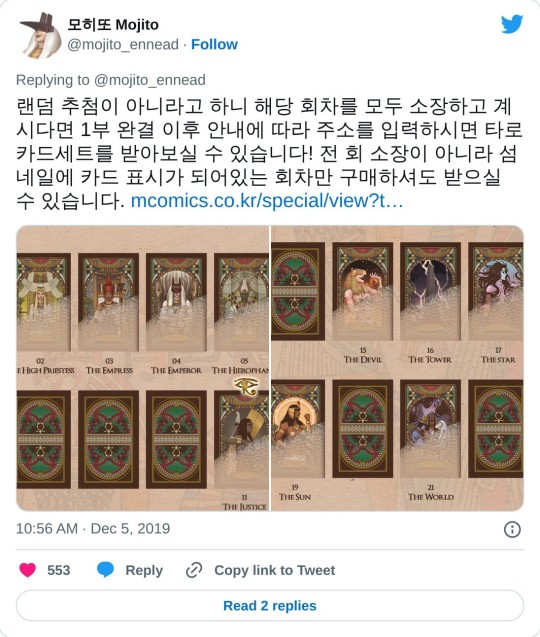
This is different from the fan-created set by Studio Papyrus, an ENNEAD fanworks group.
Modern Short Hair Seth
Mojito drew a modern version of Seth in 2021, with short hair.
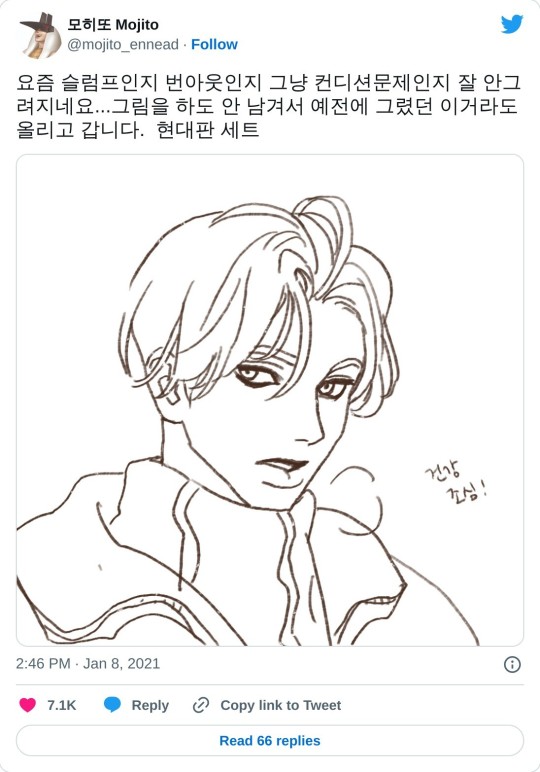
Art of Seth to commemorate the release of the simplified Chinese translation of ENNEAD

Chibi versions of the Horus lettuce marriage proposal
Seoul Comics also turned this into enamel pins. These are based on the myth where Horus comes on some lettuce/Isis spreads his seed on some lettuce, which Seth eats, as a way to show Horus' dominance in the trial for the throne of Egypt.
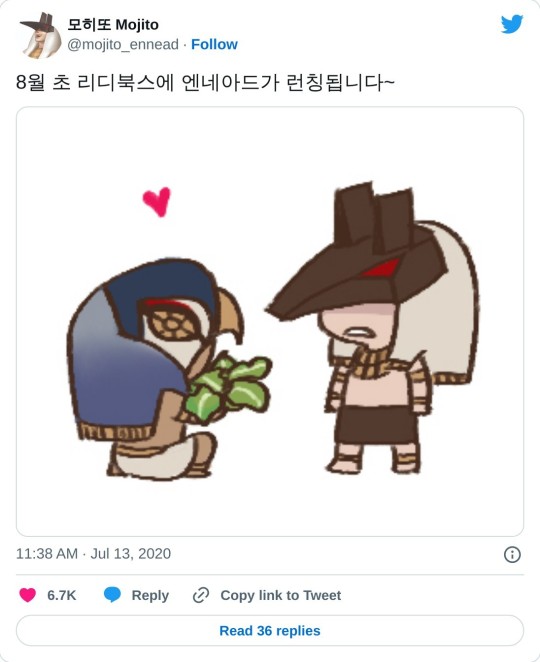
Horus and Seth in tennis skirts

Art to commemorate the work done on/for the Japanese translation of ENNEAD
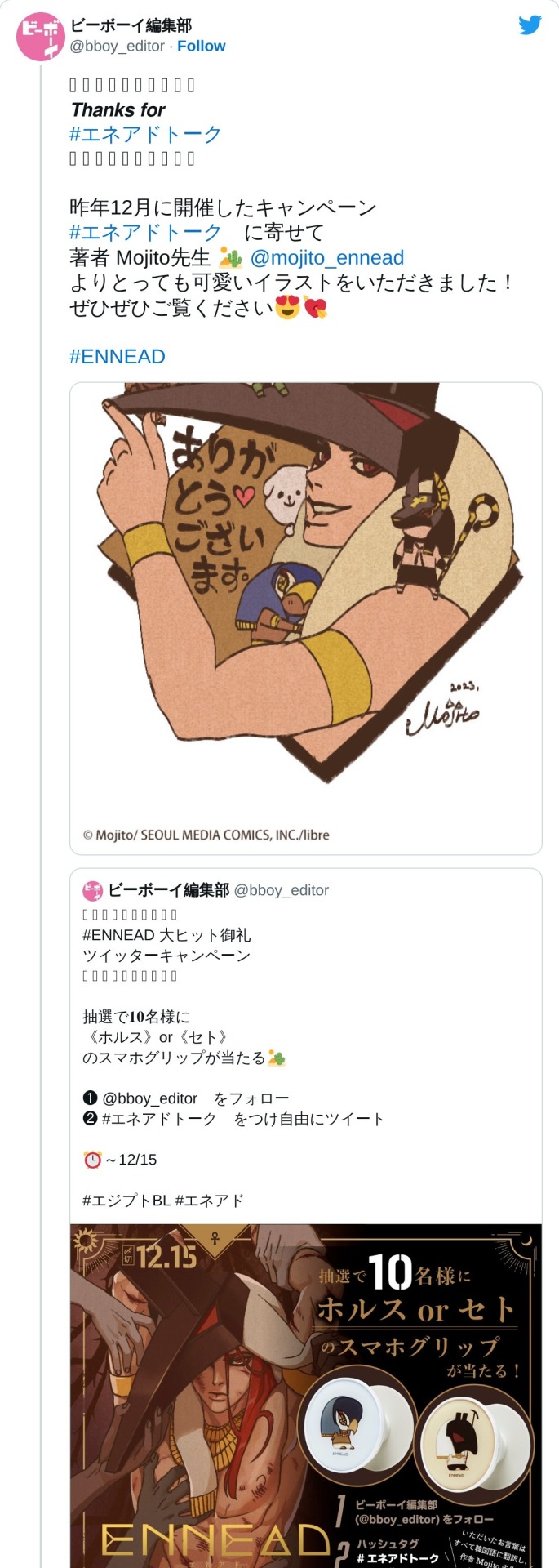
The full art for posters featuring Horus and Seth that have been sold as merchandise

Anuseth contest art
There was a contest in June 2022 for readers to vote on one of the four tops (Osiris, Horus, Foreign God, and Anubis) for Mojito to draw art of with Seth. Anubis won, and the resulting artwork is available for free on the Korean version of the manhwa between Season 2, Episode 44 and Season 2, Episode 45.
Horus/Seth, Anubis/Seth, and Osiris/Seth couple checklist as answered by Mojito
Sometime prior to March 22, 2021, Mojito answered couple checklists for Horus/Seth, Anubis/Seth, and Osiris/Seth in Korean, essentially explaining how the characters act in a relationship. It's unclear where she answered these, but it was likely on her postype. Screengrabs included below. The original posts have seemingly been taken down.


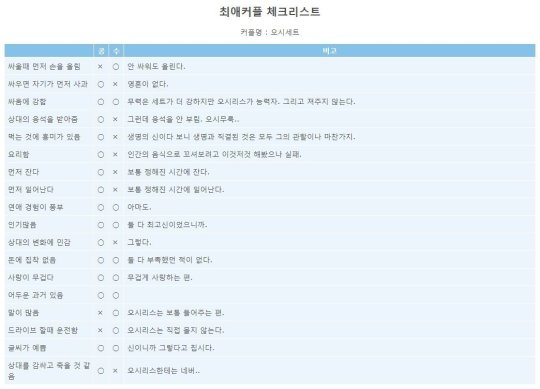
65 notes
·
View notes
Text
Senyuu AU Masterpost
I asked if I should do this on Twitter but Twitter is trash for big posts like this so I’m posting it on Tumblr.
I’m calling this an AU masterpost but I’m including canon alternate versions of characters too. I’m writing this assuming you don’t know anything past S4, but it will contain spoilers for F5 and the Haruhara Robinson Channel content.
Since the majority of these AUs are entirely fan-based with only the slightest bit of official content, I’ll also discuss common fanwork concepts, including things like special ship names for particular AUs.
Table of Contents
Common AUs
Web
SQ
High School
Magical Girl Alfo-chan
Visual kei
2P
Less Common AUs
High School Detectives/Police
Himura + Yami
Rosicks + Hialba
Sheepba
Wild West
Obscure AUs/Outfit Changes
Feral Ros + Adventurer Alba
Formal Wear
Karaoke
Kindergarten
Saeki-san
Scientist Ros
University
Urashima Tarou
Vampire Ros
Wedding
Canon-Adjacent AUs/Canon Alternate Characters
Albatross
Boss + Sleepiez
Creasion + Maoruba
Elf’s Universe (”0verse”)
Meta Ros
This got super-long so I highly suggest using CTRL/CMD+F to jump to just the ones you’re interested in!
Common AUs
All the AUs in this category are universes you see everywhere in fan content, regardless of how much official content there is for it.
Web

Alright, this isn't an "AU", but including it for completion's sake. This is the main canon, the original Alba and Ros from the original webcomic. The anime and the Main Quest manga can be considered to be equivalent to the web-verse.
Official Japanese | English Scanlations
SQ

(Image from Jump SQ’s website.)
SQ is an “official” Senyuu AU - it’s basically Senyuu if Alba and Ros kept their Season 1 dynamic forever and nothing really bad ever happened. Haruhara has said a number of times that an important thing about SQ is that everything sad has gone poof, which is why he decides against giving a sad dramatic reason why Ros’ name went from Sion to Ros in SQ-verse. Other notable changes in SQ include Januar being human, Elf being a demon, and Foyfoy being cute and shy.
Senyuu SQ originally ran in the Jump SQ magazine for thirty chapters (Official Japanese | English Scanlations), named as such because of the magazine it ran in. More recently, Haruhara began releasing SQ Senyuu! on his channel, where the SQ stands for Super Quality and definitely not anything copyrighted (Official Japanese | English Scanlations.) The chapters released on his channel were sometimes in draft form, so he additionally inked some and released it in doujinshi form (Official Japanese | English Scanlations), along with a doujinshi-exclusive chapter.
Senyuu SQ Alba (seen above) looks identical to Web S1 Alba. SQ Senyuu! Alba (seen below) looks like Web S2 Alba but short and without the Red Fox scarf. SQ Ros doesn’t change appearances between Senyuu SQ and SQ Senyuu! He has the Web S1 Ros hairstyle, but lacks his armour and sword - his bat is his most defining feature.

High School
There’s actually two different high school AUs:

SQ Academy: There’s three omake chapters in SQ Senyuu where everyone is in high school - see here and here, in volumes 1 and 2 respectively. In the SQ High School AU, Ros, Alba, Hime-chan, Foyfoy, Januar, and Rudolf are students, while Rchi is a teacher. Alba is the president of an unnamed club with Ros as a club member.

(Image from Haruhara’s twitter.)
Soccer Club Drama CD: This drama CD was released with one of the MQ volumes. You can only buy the original Japanese on auction sites now, but you can listen to the audio and read a translated transcript here! This AU features only Ros, Alba, and Crea, who are all part of the same soccer club. Alba is the club president.
In both AUs, Ros calls Alba “Prez”. The canon content for both AUs is rather sparse, so the Prez thing is usually the only thing that’s retained in most fanworks. Reincarnation stories are pretty popular in fanworks, but there’s no hints or implications in either official High School AU that it’s connected to SQ or Web canons. Usually people use the Drama CD designs (probably because they don’t want to draw Ros with S1 hair.) Sometimes they use the SQ Academy designs at the start, then change to the Drama CD designs in second-year or something.
There’s also the Senyuu Light Music Club from one of the web omakes, which features Crea and Elf. I haven’t seen any works incorporate it though.
Japanese terminology glossary
High School AU: 学パロ - Gakuparo
Prez: 部長 - Buchou
---
Magical Girl Alfo-chan
This is the mahou shoujo parody of Senyuu, featuring Alba as a girl - Alfo-chan - and Ros as a cat - Roll.
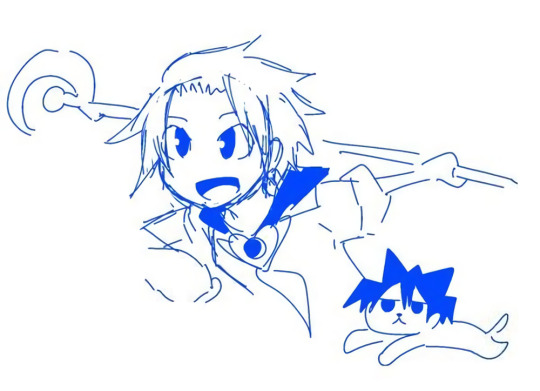
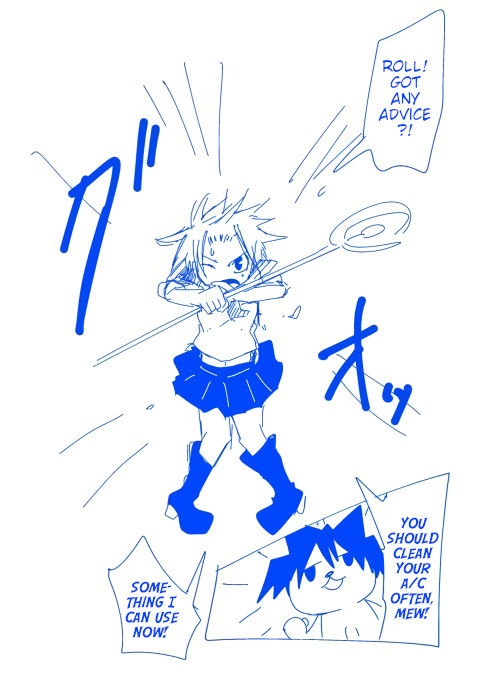
(Image no longer available online.)
Roll is usually made into a cute catboy that can transform into a cat, because I mean, why wouldn’t you. And also presumably people want a Roll they can ship with Alfo-chan. For some reason there’s also a lot of works that ship Alfo-chan with Creasion, though I’m not sure where it came from.
The “official title” of this parody is actually Magical Princess Alfo-chan, not Magic Girl Alfo-chan, and most fanworks on pixiv are found under this name.
Japanese terminology glossary
Magical Princess Alfo-chan: マジカルプルンセスアルフォちゃん
Alfo: アルフォちゃん
Roll: ロール
Alfo/Creasion: アシルフォ - Ashirufo
Alfo/Roll: ロルアル - Roruaru
---
Visual kei
Visual kei is a music genre - you can read about it here. This AU started because Haruhara drew a pic of Alba and Ros in visual-kei-like outfits, and then it all spiraled from there. There’s three images that fuel this entire AU:
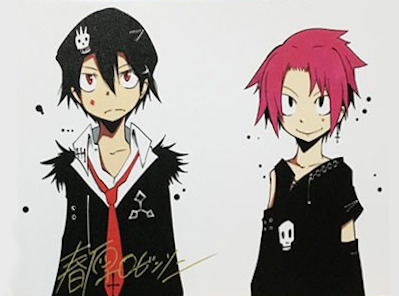
(Image from Haruhara’s twitter. Note that you can find a higher quality scan of this art if you download this artbook scan here.)
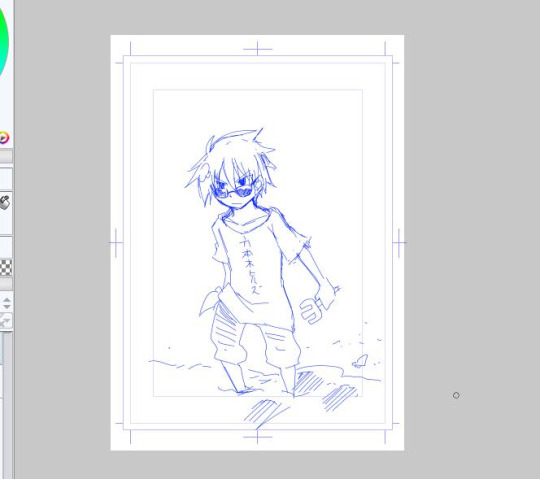
(Image from Haruhara’s twitter.)

(Image no longer available online.)
The Alba and Ros in the first image were dubbed Visual-ba and Visual-ros, the Ros in the second image “Roppongi” (because his t-shirt says “Roppongi Hills”, and the Alba in the last image “Kuroba” (because Kuro means black and he’s black-haired.) Why were the bottom two images lumped in with the first? That’s a mystery that may never be solved.
There’s two common variations of the AU in fanworks.
The first is where Kuroba + Visual-ba and Roppongi + Visual-ros are two pairs of brothers, and typically the pairings go Kuroba/Visual-ros and Roppongi/Visual-ba. In this variation, Visual-ba basically always gets to be Alba, while Roppongi and Visual-ros often take the names Ros and Sion respectively.
The second common variation is where Kuroba and Roppongi are just the civilian identities of Visual-ba and Visual-ros, which doesn’t have a pithy shipname in Japanese.
With regards to their visual kei identities, I’ve also usually seen two main variations - either Alba and Ros are currently in a singing group together, or Ros used to be a famous singer and Alba is currently trying to get famous under his tutelage.
Haruhara has also recently posted a glow-up pic of Visual-ba, bringing the grand total of official art in this AU to... four.
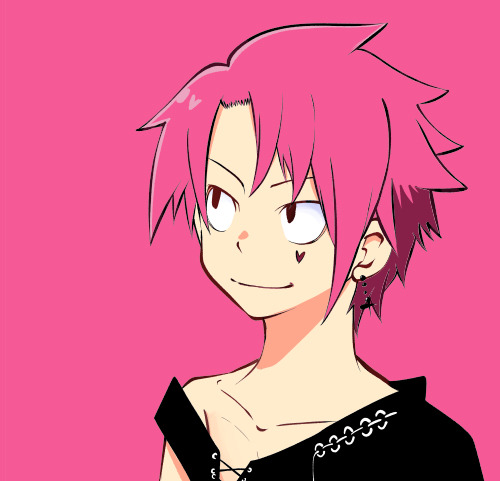
Japanese terminology glossary
Visual kei: ビジュアル系 - vijyuaru kei (Note that while technically ヴィジュアル is the correct term in Japanese, in the Senyuu fandom, ビジュアル is used for everything, probably because it’s easier to type and say.)
Visual-ba: ビジュアル - bijyuaru
Visual-ros: ビジュロス - bijyurosu
Roppongi: 六本木
Kuroba: 黒髪アルバ - Kurokami Alba (lit. Black-Haired Alba) --> クロバ
Kuroba/Visual-ros: ジュロ黒 - jyurokuro or 黒ジュロ - kurojyuro
Roppongi/Visual-ba: 六ビジュ - rokubijyu or ビジュ六 - bijyuroku
Visual-ros/Visual-ba: ビジュロスアル - bijyurosuaru, 派生ロスアル - haseirosuaru
---
2P
“2P” is used in many fandoms to refer to alternate character designs that are often associated with different personalities as well. In Senyuu, the official 2P designs are all alternate colourings:

(Image from Haruhara’s pixiv.)
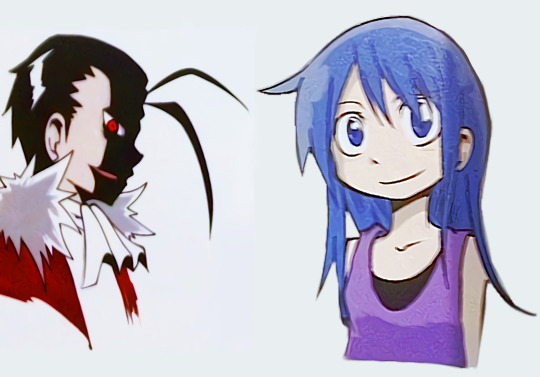
(Image from one of Haruhara’s artbooks which doesn’t seem to have an online scan, sorry for the bad quality.)
Likely because the bottom two are only available in an artbook, I haven’t seen many fanworks with them. 2P AUs tend to be only 2P Alba and Ros, with some occasional 2P Rchimedes or 2P Crea (who’s typically drawn as 2P Rchimedes with short hair.) 2P Ros is usually drawn with blue eyes, presumably to match with his red Mana Maker. 2P Rchi is also common enough - she tends to be drawn with a blue and black scheme, to contrast with her canon pink and white scheme (example).
2P Alba and Ros have varying personalities in fanworks, but the one consistency seems to be that their personalities are nothing like canon. 2P Ros tends to be the silent serious type or a yandere. 2P Alba tends to be an innocent happy boy or a yandere. You may be seeing a pattern here.
Note also that 2P Ros is usually referred to as 2P Creasion, for obvious reasons.
Japanese terminology glossary
2P Alba/2P Ros: 2Pアシアル - 2P ashiaru or 2Pアルアシ - 2P aruashi. Both are sometimes shortened by removing the “2P”.
Less Common AUs
These AUs aren’t seen quite as much as the juggernauts above, but you’ve probably still seen them around occasionally.
High School Detectives/Police
There’s a few different detective-related fanworks floating out there, based on one of the three official chapters: Detective Ros in Senyuu SQ, Senyuu Police from the webcomic, and High School Detective Teufel in Main Quest Vol. 6, which hasn’t been scanlated yet (runs):

I haven’t seen too much art of High School Detective Teufel, but I’ve seen a couple fics and art out there for both Senyuu Police and Detective Ros, mostly Senyuu Police.
Himura + Yami
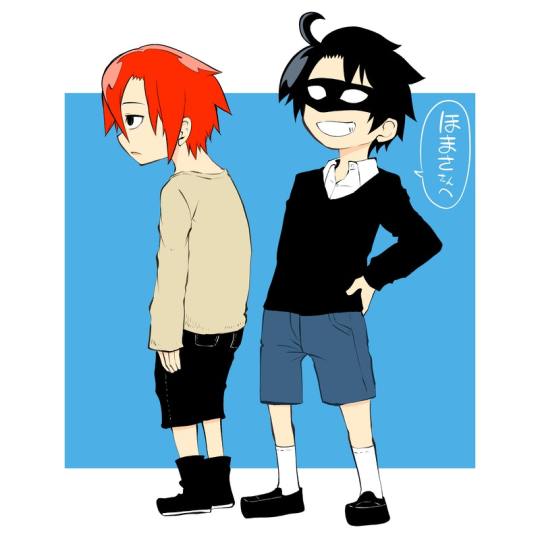
(Image from Haruhara’s Skeb.)
This isn’t really a Senyuu AU, but it shows up enough to include it here. Himura and Yami are two characters that Haruhara drew - you can see this original picture of them on page 12 of the artbook here. Himura is the redhead - at first, he meant to draw Alba, but he decided in the end it wasn’t Alba anymore and renamed the file to “Himura,psd.” Yami is just a fan-name - he’s only referred to as “the boy that shouldn’t be seen” in the artbook. Himura and Yami eventually appear in Gakumon! with the names Rahimu and Damia respectively.
Senyuu fanworks that include them usually have Himura being an Alba that fell into despair after Ros’ disappearance, while Yami is a physical manifestation of his despair.
Japanese terminology glossary
Himura-kun: 火村くん
Himura-kun/Yami: やみひむ
---
Rosicks + Hialba
This is yet another AU that was born from a mere two pieces of official art:

(Image from Haruhara’s twitter.)

(Image from Haruhara Robinson channel.)
The first picture is entitled “Soldier Rosicks” - Haruhara posted it saying it was a Ros beta design. The second picture is an scrapped Alba design for web season 2. Hialba was originally revealed on the NicoNico channel Hiaruron that Haruhara shares with a couple other artists, and so he got the name “Hiaruba” --> Hialba from the channel name.
Fanworks typically have Hialba as dead inside and sad because of Ros’ disappearance, and Rosicks as a gruff irritable guy who isn’t Ros and doesn’t like being compared to him. Cue angst because Hialba sees Rosicks as just Ros, etc.
Japanese terminology glossary
Hialba: ひあるば
Rosicks/Hialba: ロシひあ - Roshihia
---
Sheepba
Sheepba originates from a New Year’s illustration Haruhara made for the year of the sheep:
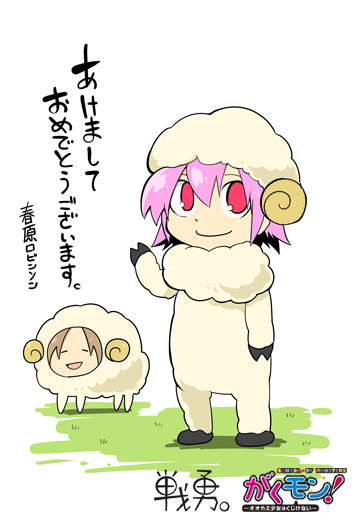
(Image from Haruhara’s pixiv.)
While Haruhara has done this for multiple years - there’s illustrations of Alba as a dog, a rat, etc. - Sheepba in particular became particularly popular. Why? Is it the floofy body? The innocent expression? Nay. I say there’s but one reason for Sheepba’s popularity in comparison to other Chinese Zodiac/Alba hybrids-
Haruhara has produced a crapton of Sheepba merch over the years.
I believe he’s made coloured sheep versions of other characters too for merch, but I unfortunately wasn’t able to find any of them. I was, however, able to find outlined drawings of them:
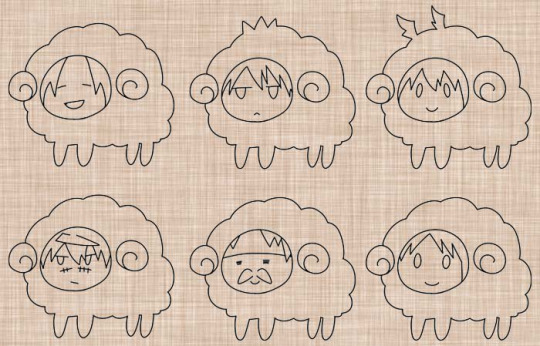

(Image from Haruhara’s twitter.)
Enjoy this flock of Senyuu sheep. And be prepared to see some uh... questionable things if you choose to browse the ひつじるば - Hitsujiba tag.
Wild West

This AU comes from the Wild West parody in this chapter. The fanworks I’ve seen tend to have Ros be some dangerous outlaw with a huge bounty.
Obscure AUs/Outfit Changes
These AUs tend to be only used as outfit changes, or aren’t seen often at all.
Feral Ros + Adventurer Alba

Basically a Tarzan AU. Based on this Haruhara Channel comic: Official Japanese | English Scanlation.
Formal Wear
You may sometimes see Alba and Ros wearing suits. There’s two pieces of art this originates from:
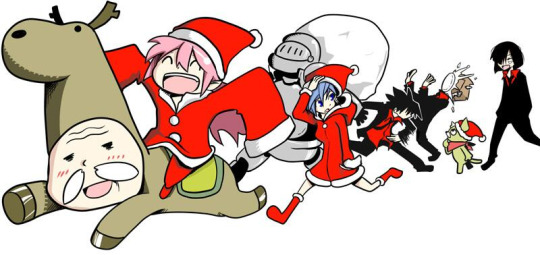
(Image from Haruahara’s twitter.)

(Image from Haruhara’s twitter.)
There’s also a corresponding Ros-in-suit-with-striped-shirt photo that you can see in the artbook here.
Karaoke
You may have seen characters dressed up as what seemed like waiter outfits. That may have come from the Senyuu Karaoke collaboration that happened around when the anime aired:
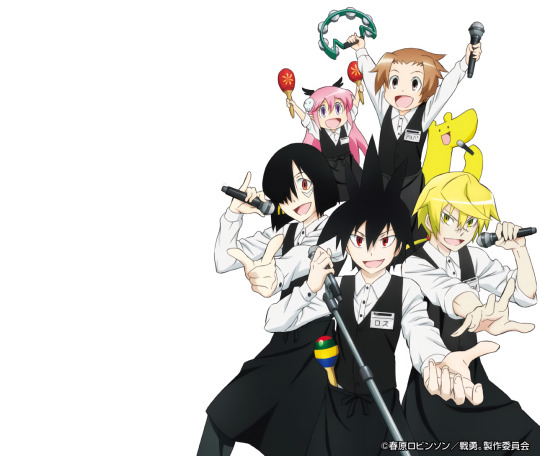
(Image from collaboration website.)
Kindergarten
This comes from the recent Haruhara Robinson channel comics - Senyuu Kindergarten Story #1 and Story #2.

It features Alba and Rchi as kindergarten teachers to the rest of the Senyuu cast.
Saeki-san
Haruhara was the writer for a manga called Dignified Asleep Saeki-san (Official Japanese | English Scanlations), which was a romcom that featured a girl called Saeki determined to sleep in class, and a boy called Tokimiya who sits next to her.
When the manga began serialization, Haruhara drew a parody sketch of the manga where Ros is Tokimiya and Alba is Saeki.

(Image from Haruhara’s twitter.)
Scientist Ros
You may have seen art of Ros wearing the glasses + lab coat combo from when he made the Mana Maker in season 3:
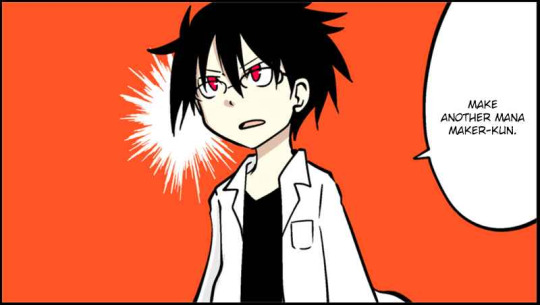
Or from when Alba had his... questionable body measurement exam in Senyuu+:
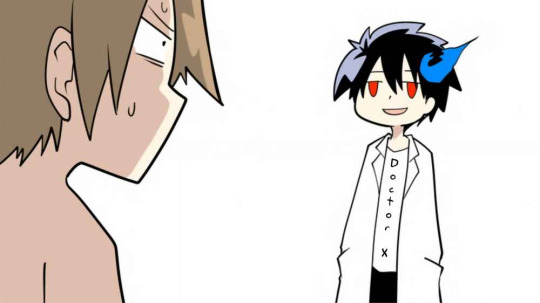
Or when they both wore glasses in the Haruhara Robinson Channel doujinshi Crea-kun Has Cheerfully Fallen to the Dark Side:
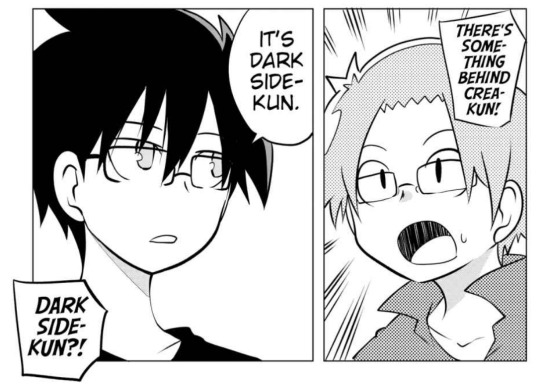
University
A while back, Haruhara drew a picture of Alba and Ros in the winter wearing coats:

(Image from Haruhara’s pixiv.)
A little more recently, he was commission to redraw the image:
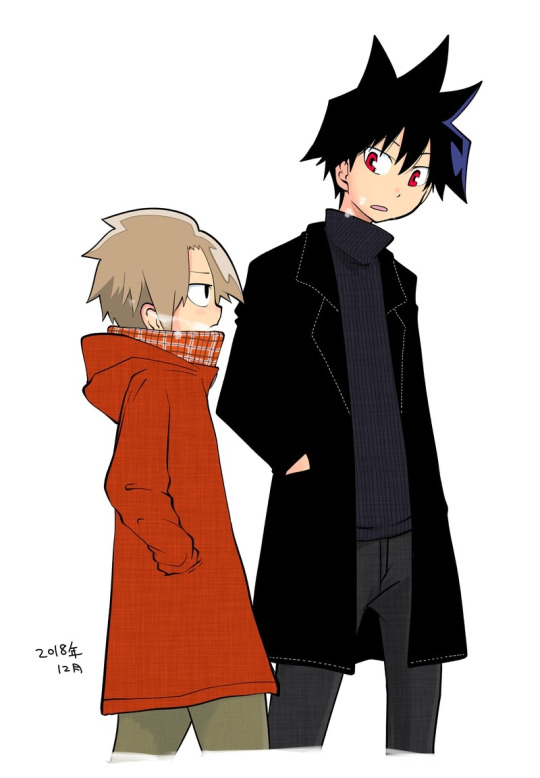
(Image from Haruhara’s pixiv.)
Fanworks that use Alba and Ros in these outfits often treat them as university AUs (and usually have them on a date.)
Urashima Tarou
Urashima Tarou is an old Japanese fairytale which Haruhara used as the setting for one of his omake segments. If you’ve seen turtle Alba:

Or Ros in old-timey fishing clothes:

That’s where it’s from.
Vampire Ros
The typical Vampire Ros design comes from an SQ chapter where Alba and Ros disguise themselves as demons after chasing Elf into the demon world.

Alba is usually either a werewolf (presumably because werewolves and vampires are a common pair) or some hapless human that Ros sucks blood from.
Wedding
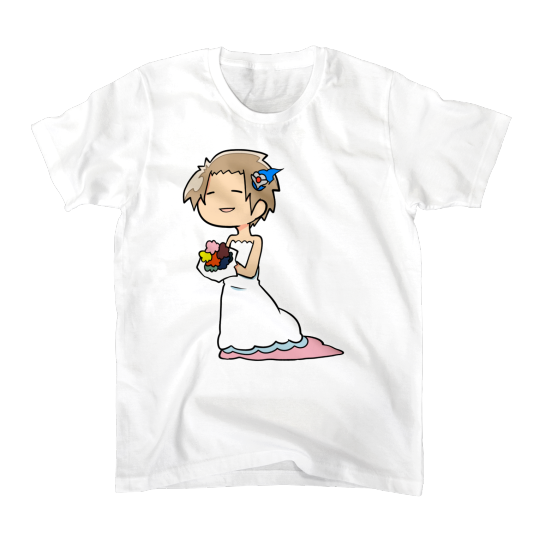
(Image from Haruhara’s twitter.)
Haruhara drew this when he was getting married(?) because it apparently felt less embarrassing to draw his protagonist getting married than to draw him and his wife.
Fans promptly used the outfit to marry Alba off to Ros, likely galvanized by the Mana Maker + Hero Symbol combo on Alba’s head.
Canon Adjacent AUs/Canon Alternate Characters
Moved to an overflow post here because this one got big enough that Tumblr stopped saving my post.
#senyuu#senyuu content#senyuu spoilers#my commentary#no point in tagging much#there's an approximately 0% chance tumblr will let this show up in search#I added so many links and images
38 notes
·
View notes
Text
TAZ: Balance as a musical
So I was sitting at my sister’s show choir concert one semi-recent evening- you know, like you do- and I had this weird thought: what if The Adventure Zone: Balance was adapted into a Broadway musical? After sitting on this post for what feels like aeons on account of me accidentally forgetting I’d saved it as a draft, I thought I’d share my thoughts on this bizarre topic.
• The songs are a mix of actual TAZ songs set to lyrics, completely original pieces, and covers/parodies of other songs.
• Each arc is covered in the space of about fifteen minutes, with the total play taking a little over two hours. This obviously leads to quite a few scenes either being cut or being covered in the space of a montage number, similar to “Drive” from the Lightning Thief musical.
• The first musical number takes place in the tavern where Tres Horny Boys first meet up, and is about their past exploits and what they’re looking for on their adventure. Magnus and Merle both have their own verse; Mangus sings the first chorus alone, and then both of them sing the second chorus together. Then the two try to ask Taako about himself, and initially he declines to give an answer, so the spotlight instead turns to Barry Bluejeans; he prepares for his own verse... and then Taako’s like “wELL SINCE YOU ASKED” and all the spotlights immediately swing towards him as he belts out his own verse. The last chorus is of course sung by Tres Horny Boys in harmony.
• The Voidfish is a massive elaborate puppet which is suspended from the ceiling Peter Pan-style; Junior, meanwhile, is a hand-puppet controlled by Angus McDonald, who pulls him out of the tank while excitedly going on about how cute the baby Voidfish is.
• The Fantasy Costco jingle is expanded into a full musical number, which plays during the first (and only major) Lunar Interlude. Rather than having a visit to the Fantasy Costco between every arc, the play instead opts to have a single extended visit shortly after the Boys officially join the Bureau; the musical number is interspersed with scenes of the Boys buying various items which will be used later in the play. Garfield the Deals Warlock is wearing a heavy robe and a Garfield the Cat mask, so the audience can’t tell what he really looks like (if indeed the mask is not supposed to be his face).
• I can vividly see the way the Merle’s Arm Incident is handled. Kravitz’s portal opens just offstage, so Merle wanders off in the middle of the conversation. Then, as Magnus and Taako are discussing something else, Merle sprints back into the room screaming that his arm is turning to crystal; at this point, the actor playing Merle has a Plexiglas arm shoved into his sleeve, his real arm withdrawn into his shirt and clutching the fake arm. Magnus brings his battleaxe down on the fake arm, at which point the actor drops it and falls to his knees screaming (possibly going into a musical number). When Merle gets his wooden arm, said arm is a similar prop when it’s first given to him; in all future scenes, it’s part of the costume itself and done with makeup.
• When Merle does his “My name is Elder Merle” goof in The Eleventh Hour segment, the orchestra actually plays the few notes of “Hello” from Book of Mormon; the music trails off as Merle is rebuffed.
• Lucretia doesn’t get a solo song until the end of Reunion Tour / start of Stolen Century, and her big solo number is called “No Words”; it’s a heartbreaking ballad about the journey of the Red Robes, and how she can’t even begin to describe how painful it was to do what she did. (I’m a terrible songwriter, but I keep imagining the first chorus ending with the lines “We flew through the universe like seven birds / But when I try to speak of the pain I feel, I have no words”.)
• JeffAndrew always has to be played by either the director of the play or another member of the production team.
• The very last song in the musical is a joyful reprise of “No Words” in which Lucretia summarizes the events of the time-skip and what Tres Horny Boys and the others have been up to; the song has new lyrics to reflect that, now that the Hunger is finally defeated, she has no words to describe how happy she is to have her family back together.
Please reblog if you have any additions of your own!
#taz balance#the adventure zone#the adventure zone balance#taz#magnus burnsides#taako#merle highchurch#lucretia#angus mcdonald#garfield the deals warlock
2K notes
·
View notes
Photo

WIP Intro: Second to None
trapped in another world | magic and dragons | found family | unreliable narrator | no fourth wall
YA Fantasy Parody
First Person
First Draft
300 followers later, it’s about time you damn fool
Synopsis:
Cam, Thea, and Tani were unprepared for Derhise, a treacherous land of magic and dragons. I mean, how do you make sense of that exactly? Being hit by a magic lighting bolt and waking up in an unfamiliar, fantastical, vaguely medieval world? Thankfully, they’re not in this alone. What could possibly go wrong when you have an oracle-in-training and a dragonrider on your side? (read: all of the things.) With an ancient evil stirring, whispers of a corrupt throne, and the very existence of magic on the line, these kids are going to have to start running in the opposite direction very very fast.
Excerpt:
“Yeah,” she says nonchalantly, “wait, Nick didn’t tell you?”
Nick crosses his arms. “I thought you fellows told him while I was standing trail.”
I frown. “He spent the whole time talking about you!”
Nick buries his face in his hands, then turns sharply to bark at Pat. “Guild master, with all due respect, that is despicable and also creepy!”
Then it’s Tani’s turn to frown. “Hold it, you didn’t tell him while you were waiting to stand trial?”
“No! I didn’t! Because I thought you were going to tell him! And I had to brief him on each of you so he wouldn’t freak out at all your,” I’m afraid of what he’s using this pause to pick out, “- your Mirror Worldliness.” Oh, that’s not so bad.
Joey meows loudly as if reacting to a bad joke. Fair point, the cat’s not dull at all.
Thea squeaks, “Wait, what did you say about us?!”
Nick groans and points back at Thea. “You believe in magic,” he swivels round to point at Tani, “skeptic,” and he swivels a little more to land on me, “and you don’t care either way.” Huh, kid hit the nail on the head.
In summary!
Is there a prophecy?
Is there a lost heir that must be returned to the throne?
Is there a Resistance?
Is there a Chosen One?
You’re damn right there is, and so much more! But it’s unlike anything you’ve ever read before. It’s a bit like this post really: looks about right on the outside but the closer you read, the more apparent it becomes that it’s just me mucking around. And well, hey, if you remain unconvinced, could I interest you in the prospect of a teleporting cat?

Look at him! His name’s Joey and he loves you! why yes i have a faceclaim for the cat but none for any of the human characters, glad you asked
WIP Tag
Tag list (ask to be added/removed!): @allisonilluminated @acedragonwriter @tanglewood-queen @bach-2-the-future @thebravelittletoasterthatcould @littlesilverlightning
#wip intro#wip introduction#wip#writing#writeblr#amwriting#cookie's stuff#fantasy#ya fantasy#parody#so excited to finally get my book baby out there#the cat is also there#writers on tumblr
6 notes
·
View notes
Text
'Younger's Best Author Parodies, From Quinn Tyler To Edward L.L. Moore

New York media has been the backdrop for what feels like millions of TV shows about women chasing their dreams. But so few get it right. (I’ll never forget the series in which a magazine editor berates a writer, “You didn’t even leave space in this story for ads!” Which, for the uninitiated, is something an editor would never be concerned with.) But despite Younger’s outlandish premise — a rom-com about a 40-year-old woman passing for 26 — it’s become perhaps the most authentic show ever about the world of book publishing. Through seven seasons, it’s delivered plots that lived and died by the peculiar inner workings of publishing — and managed to make dishy twists out of inside-baseball stuff like bulk sales and imprint/parent company dynamics. Don’t tell anyone who worked on my own novel, but the jargon I tossed off in conversation? Hilary Duff taught me all of it.
The best part of Younger’s evolution into an industry love letter is its prescient author characters, who always feel ripped from the splashiest book world conversations. See: this season’s Greta Thunberg dupe, played to yellow-slickered perfection by Nadia Alexander. “She has our favorite name from Season 7,” writer and executive producer Dottie Zicklin tells Bustle. “Füpa Grünhoff. Her name wouldn’t clear [with the show’s lawyers] until the umlauts were added!”
Füpa is just the latest in the show’s list of standout faux scribes, whose spot-on plotlines were in part the work of the show’s anonymous publishing consultant, who helped guide the staff on the industry’s trends and conversations. We still can’t reveal his or her identity, but we did get to talk to the consultant — along with Younger creator Darren Star, Dottie Zicklin, and fellow executive producer and writer Eric Zicklin — to get the stories behind how the show’s most iconic fake authors came to life.
Season 1: Jane Krakowski as Annabelle Bancroft
Bancroft, played with nightmare-diva energy by the 30 Rock star, was based on Sex and the City author Candace Bushnell. Star famously made the series based on that book, so an homage to Bushnell — in the form of Bancroft’s iconic scenester who spends her book launch party smoking indoors and fixating on the size of the crowd — felt like a safe place to start testing author parodies. “I thought Jane was hilarious playing [a version] of my friend Candace,” Star says. “She really made me laugh.” Writer and executive producer Eric Zicklin adds: “We loved her double-bounce off the glass door most of all.” (Bancroft runs into the door while chasing her coke dealer. Twice.)
Season 2: Kobi Libii as Rob Olive
This caricature of John Green — complete with a soulful leather necklace — hit just as I realized I was reading books about dying teen lovers almost exclusively. Libii is perfectly troubled and self-serious as the bestseller workshopping a Fault in Our Stars-style YA romance with Hilary Duff’s Kelsey at lunch. (Ever the brilliant brainstormer, it’s Kelsey who comes up with the idea for a hospice prom.) “We learned the term ‘sick lit,’ and the genre seemed natural for Millennial Press’ readers,” Dottie Zicklin says. “Trying to say John Green” — aka the author of Fault — “without using the words ‘John’ or ‘Green’ led to a great name.” Long live Rob Olive.
Season 2: Justine Lupe as Jade Winslow
With Lupe’s flaky influencer character, Younger dipped into the hazards of traditional publishing chasing Instagram sensations — Winslow gets a huge memoir advance, then fails to deliver a single page of work. (Liza has to cobble together a draft from the girl’s Instagram captions.) “The younger Younger writers brought up Cat Marnell as inspiration,” Eric Zicklin says. Marnell, a former beauty editor and socialite, wrote the smash 2017 memoir How to Murder Your Lifeabout her drug addiction and magazine-world adventures. “That story led Kelsey and Liza into learning about the balance between hype and substance.”
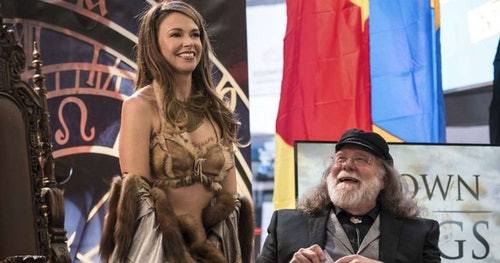
Season 2: Richard Masur as Edward L.L. Moore
Between his aggressive rascalling around the office and his misogyny, the show’s George R.R. Martin homage became its best work in terms of authentic publishing tension holding up plotlines. Martin’s Crown of Kings fantasy series is key to Empirical staying afloat, so he gets away with — well, not murder, but making Liza wear a fur bikini in Times Square might actually be worse? It takes Empirical far too long to do the right thing and drop the author. (Right around the time Moore debuted on the show, publishing was scrambling to reckon with its own legacy of harassment.) And when they do, Moore strikes back, outing Liza as the 40-something she is. The writers didn’t know when they started writing the character’s arc that he would unpin the show’s central secret. “We had no idea how instrumental he would become in exposing Liza,” Star says. “But Richard Masur was so hilarious that I wanted to bring him back and back and back.”
Season 3: Jay Wilkison as Colin McNichol
Remember the guy who asked Kelsey at the end of their first date to take a look at his novel? Or did you try to forget you ever heard the chilling invitation, “Come on in, I’ll print you out a copy”? Ah, the perils of being a single girl presiding over New York’s hottest imprint. Kelsey actually dates Colin for a while anyway — his 600-page epic turns out to be good, by her measure — but it doesn’t stop the character from feeling It-Boy insufferable all the way through his arc. (Which includes Netflix jumping on the option for his book, naturally.) As for the trend that inspired Colin? The big-money debut epic that seemed to dominate publishing years ago — see books that scored massive paydays like The Art of Fielding or City on Fire — has subsided somewhat. But Younger’s publishing consultant says it’s never really gone. “I think there was a moment where books like that were happening more often, but it could still happen,” the consultant says. “Everyone knows attention spans are shrinking, but people still want to find that ‘It Book’ of the year.”
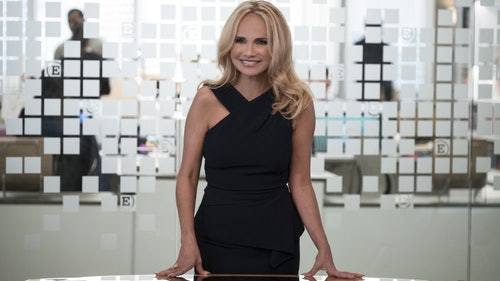
Season 4: Kristin Chenoweth as Marylynne Keller
Younger’s first episode in the post-Trump era featured Chenoweth as a Kellyanne Conway sendup who declares the world post-facts and claims that “Truth is a four-letter word.” (When Charles corrects her math, saying truth has five letters, she purrs: “Not the way I spell it.”) One trillion bonus points to costume design for the jacket that mirrors Conway’s inauguration outfit. “Not to say the show was ahead of the culture,” Dottie Zicklin jokes, “but when the national conversation became about Kellyanne Conway and Sean Spicer cajoling the truth, we felt like we were already on that topic. Liza was living it from episode one.”
Season 5: Gina Gershon as Chrissie Hart
If you had Patti Smith’s Just Kids and Chrissie Hynde’s Reckless on your rockstar memoir shelf, you were so ready for this plotline starring Gershon in heavy bangs and week-old eyeliner. She plays Chrissie Hart, a famous singer whose memoir Charles and Liza chase to Shelter Island. (Obviously, Chrissie Hart doesn’t email drafts, because the internet is suspect.) The head of a major publisher personally retrieving a manuscript, messenger-style? Zany but plausible, the show’s consultant confirms. “If anyone’s ever worked on celebrity books, they are their own beasts — totally fun and awful and amazing,” the consultant says. “You know what you’re in for, and yet we can’t help ourselves because they sell and they’re glamorous to work on.”
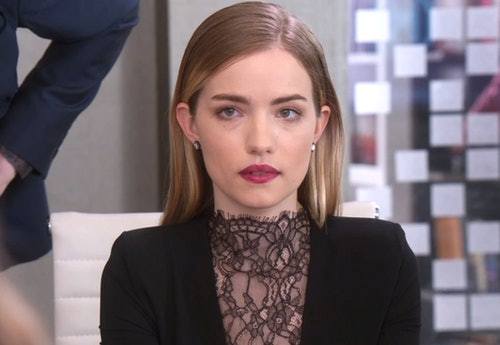
Season 6: Willa Fitzgerald as Audrey Colbert
Fitzgerald, um, kills it in this tribute to wink-wink-did-I-murder-someone-or-not books. Her character goes around shopping a memoir meant to refute her villain status on a Serial-like podcast; she’s chaperoned by Michael Urie’s Redmond. (The only lit agent in New York, according to Younger, but would I want Urie sharing screen time? I would not.) Fitzgerald’s dead-eyed smize is what gives this character her hall of fame status. As Dottie Zicklin says, “Willa was able to give that staredown that says ‘beware’ and ‘I might have sex with you right now.’” Eventually, though, a press outcry kills the project — totally realistic, according to the show’s consultant. “If you are dealing with someone who the public believes to be guilty, or unworthy of a book deal, that can bring a major backlash,” the consultant says. “See Jonathan Mattingly or Josh Hawley — and, years ago, O.J. Simpson.” Yeah, remember If I Did It? Unlike Beaufort Books, the shop behind that one, Empirical eventually declined to publish Colbert’s book.
Season 6-7: Laura Benanti as Quinn Tyler
Quinn is the one Younger author who’s transcended cameo status. Once a Sheryl Sandberg parody in a wiggle dress, she’s become a prolonged meditation on the subject of women doing it all. “To us, the key to Quinn was understanding that she’s just as smart and successful and impulsive, and just as tone-deaf, as any male billionaire,” Eric Zicklin says. This season, Quinn becomes much more than a villain with an endless font of ice-queen comebacks — proof that Younger is well versed in publishing’s golden rule: Never judge a book by its cover.
Get More Dating Advice Here
0 notes
Text
Powerpuff Girls 2016 - “The Trouble With Bubbles”
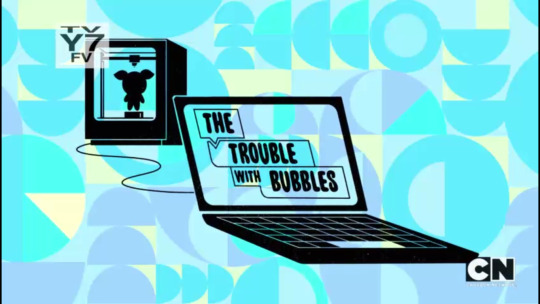
Written by: Haley Mancini
Written & Storyboarded by: Kyle Neswald, Benjamin P. Carow
Directed by: Nick Jennings, Bob Boyle
The return of Coder Bubbles!
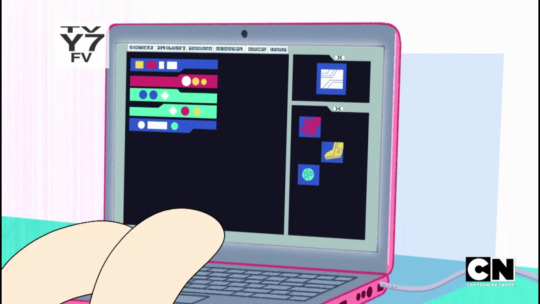
The episode starts with the first time we actually got to see her code something. We saw the end result, but never the process. She is coding a small toy based on her famous Baby Bunny game she made in Viral Spiral, which she then prints on her pretty pretty 3D printer.
This does feel more like 3D modelling than coding, even if she appear to will this bunny into existence by...using a building block-type beginner's language? At least that would explain how this character who can't spell can code. Whatever the case may be, she is glad she has all of the time in the world to do so. Nothing can possibly go wrong!
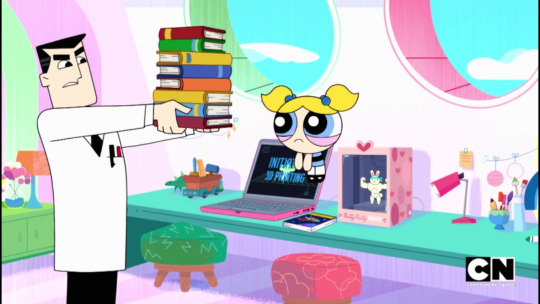
Enter the Professor, who wants her off the "computer box" so that she can do her homework. Yeah, the guy who made a simulation room and was able to make a sentient scheduling robot still calls computers "computer boxes". Can't have the Sitcom Dad's interests overlap with Bubbles' new interests, after all.
Blossom and Buttercup don't help at all, either. Blossom tells her to sign the thank you cards for people who read her thank you cards. Buttercup needs her to take care of a greased pig, because of reasons Blossom asks Buttercup for later in the episode. Needless to say, there's no answer, it's just random. She complains that she can't possibly do all of these things at once by herself. She gets an idea from this, and starts typing on her laptop.

Sometime in the very next day, according to a night-and-day time passing shot, Blossom and Buttercup are watching a show on how to tell if your friend is either an alien, or was abducted by aliens. The writing is inconsistent, big shock, I know. According to this show, aliens and/or alien-abductees are super-organized, do everything on their to-do lists, and are able to vacuum the ceiling. No points to whoever can guess what this will lead to.
Bubbles comes into the room to show that she has finished her chores. She did her homework, and even cleaned the lab! She's going to leave to wash the Mayor's car. Blossom is glad to see that Bubbles is suddenly more organized, which raises the suspicion of Buttercup, starting the second act.
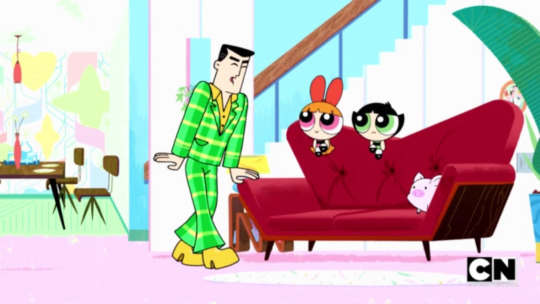
But never mind that, we get some wacky Professor hijinks! He's going on a job interview, and he wants to look stylish in his loud, green, striped suit. He's confident that. He then moonwalks away, showing that he's got the style for this...job?
They never go into specifics on what job this is, and we never find out if he got the job or not. This subplot just ends with a later scene where the Professor makes an intentionally bad joke about style. We know this because the Professor laughs, there's a comedy drum roll, and Blossom and Buttercup just stare at him. If you want to know how to tell if it was meant to be funny, wait a few minutes.

Throughout most of the first part of the episode, we focus on Blossom and Buttercup's point of view. It's up to the viewer to figure out what Bubbles did. That's actually a good idea.
Of course, they slowly realize something is not right. The biggest clue starts in this scene, where Bubbles shows off that she organized a bookshelf in order of color. This leads to Buttercup pointing this out, and a running gag where the on-screen text and narrator from that alien show shows a sign that she's an alien and/or an alien abductee.

Then she starts shaking, and starts eating the books. This isn't too far-fetched for Reboot Bubbles, and the only reaction this gets is Buttercup still saying she's an alien. Blossom doesn't even get a line.
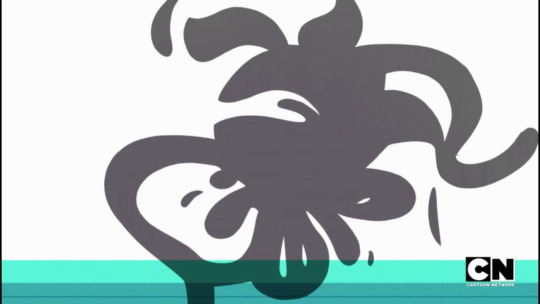
We finally get a scene from Bubbles point of view, who is relaxing, having a pretend tea party with Octi. She says hello to a face familiar to her, only for that face to turn into a monster, turning into abstract art.
Blossom and Buttercup, Buttercup notices that Bubbles happens to be vacuuming the ceiling. Even Blossom starts wondering if the alien thing can be true, until Bubbles gets distracted by a kitten in the window, slamming her face into the window. Buttercup immediately realizes that she can't be an alien, because...I don't know. Aliens don't like cats?
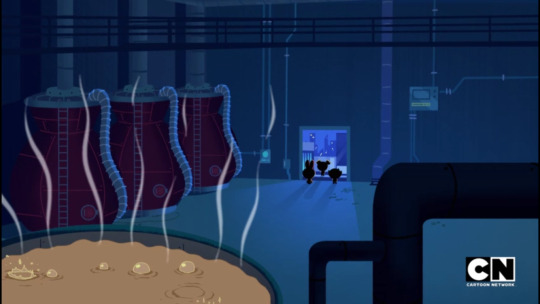
After that, Bubbles gets a call from the Mayor. Clearly, something must not be right; this is the reboot, the Mayor rarely calls them any more. They have to go to the Old Pancake Factory to fight the Breakfast Bandito. Another one of those wacky reboot-exclusive villains...or is it? They go in the building, only to find a giant pot of boiling batter and no bandito. Instead, we get some green lights and a very shadowy man.
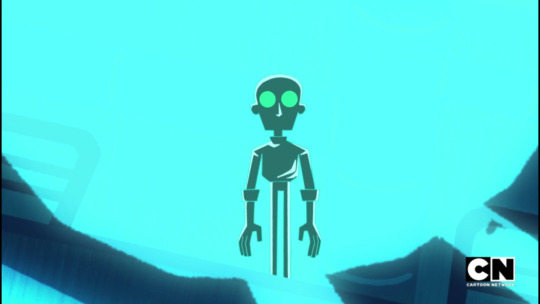
It’s Silico, in a shocking twist so surprising that Buttercup outright says there was no way anyone could have saw this coming. There is no build up to this.
The Powerpuff Girls get ready to fight the most serious villain in the whole show, until Blossom gets eye-lasered in the back. Buttercup wonders what's going on, until Bubbles punches Buttercup in the face.
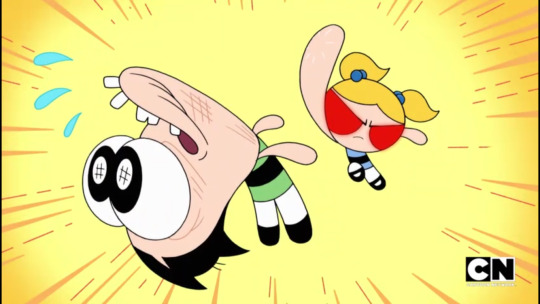
Turning her into whatever this is. Is "shocking twist reveal" really the best time for funny face jokes? I wouldn't say that.

Right after this, Buttercup is shocked that Bubbles would punch her own sister in the face, and asks Bubbles why she did that in a way reminescent of the two frame animation joke from Sister Sitter. Either the animators are starting to revolt against this reboot, or, more likely, the reboot decided to make a funny in a scene that didn't need it.
Before Silico can pass this off as Bubbles doing a heel turn for no reason, another Bubbles shows up to punch this Bubbles in the face in the exact same way. Blossom asks Bubbles what really happened, and Bubbles tells it in a very unique way...
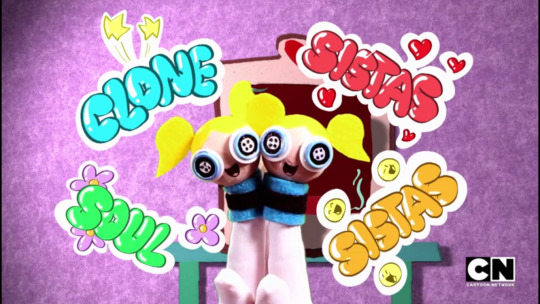
...finger puppets! I'll be honest: I have no problem with this presentation. It's reminds me of The Bare Facts, and unlike the other time they tried to emulate that, it's actually not a waste of time. As for the backstory, we're just going to expand our disbelief that the girl who can't spell can not only code well, but also be able to code and 3D print a very accurate clone of herself.
This clone is named Dubbles, clever, and she was made to do all the chores. In other words, it's like those cloning machine episodes, but the reboot managed to do it in a different way than most of them. Silico just happened to know that she did this, and hacked into Bubbles' clone to make her evil. Silico is just that good, I guess; he even knew the Reboot Puff's biggest weakness: ordinary rope! It might as well be canon.
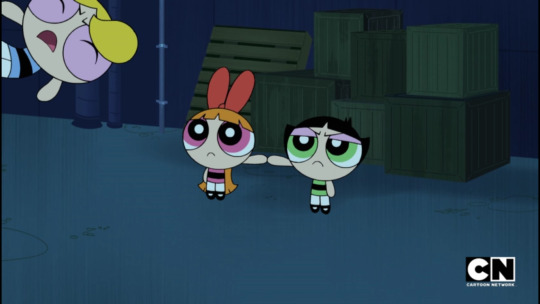
This fight scene between Dubbles and Bubbles continues as a psychadelic slideshow, only for it to pause so Buttercup can make this joke:
Buttercup: Talk about your sibling rivalries.
I usually don't talk about this show's voice acting unless it's really egregious, but I feel like this line read is missing some emphasis on the "your". I think they were trying to reference how Buttercup and Blossom fight with each other in this episode, in the whole reboot, and in the original show. How do I know it's even a joke? Well, remember when I said wait a few minutes?
Blossom: Nice. (fist bump)
There's a time for humor and a time to get serious. I should know this because there's two seperate episodes that tried to teach me this lesson. Dubbles eventually sheds her skin and reveals she now has stretchy arms thanks to Silico's improvements, grabbing the Puffs and threatening to make them a part of a balanced breakfast in the batter. At least it's a super robot grabbing them for this weekly damsel in distress situation; no ordinary rope here.
I will admit that I highlighted the worst scenes. I do like the "which one do I shoot with my eye lasers" gag, though they don't get into it that much. They get saved when a kitty cat suddenly pops into the window, and both Bubbles and Dubbles slam their faces against the window. They gave that scene a point. I guess this makes her become good again, too? They don't have time to elaborate on that.
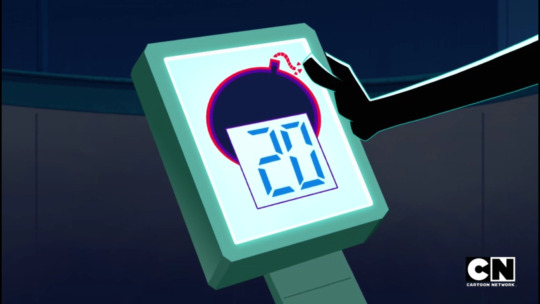
Silico not amused, he reveals that he made some other adjustments other than stretchy arms and the evil: a self-destruct button! Bubbles' new friend is about to die in a blazing death, let's see how she reacts!

Bubbles: Oh no! Silico turned her into a bomb!
Let it be a hint that the reaction to this scene is Bubbles growing buckteeth, shrinking her eyes, and shouting that Dubbles has become a bomb with about two frames of animation. They can't take it seriously, neither can I.
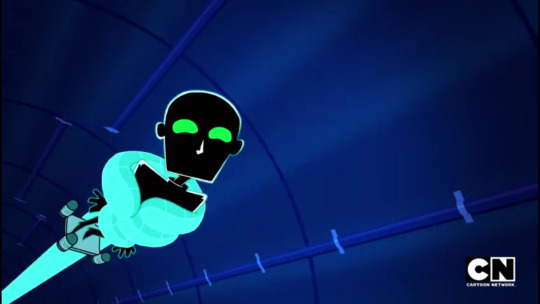
Dubbles grabs Silico with her stretchy arms, and she self-destructs in an act of sacrifice. We get a slow-motion leaping away from explosion gag. It's not until now that I realize this episode has quite a few similarities to Twisted Sister. Both involve a Puff creating a new Powerpuff Girl in order to solve being overworked, and both have the girl die at the end.
There is a massive difference in tone. In this episode, the slow motion seems to only exist to parody movies, and the episode nearly ends with the Reboot Puffs talking about pancakes and how Silico couldn't have survived that one. Dubbles dying doesn't even cross their mind; it's as if they didn't want the audience to feel sad.
This episode ends with a interesting cliffhanger. Judging by this reboot's track record, it may never be resolved. However, I do have a theory which might have explained the Professor scene, too. I don't usually do spoiler corners any more, but mouse over my rating.
Does the title fit?
Bubbles technically doesn't cause the trouble in this episode; it was all Silico's fault. She is a troublesome character in the meta sense, though.
How does it stack up?
They had some good ideas, especially with how cliched "cloning machine" episodes tend to be, but, much like Bubbles' clone, this episode has some issues. The whole second part has a lack of focus, and the ending, not the cliffhanger, feels rushed. As it stands, it's an episode that teeters between Happy and Neutral, and it slightly missed for me. A very high Neutral.

This is the last episode of PPG 2016 for the year. There were some bad times, there were some okay times, and the bad times weren’t nearly as bad as the worst times with one exception. Here's to the new year, where everyone's favorite new character returns.
← You’re A Good Man, Mojo Jojo ☆ Never Been Blissed →
4 notes
·
View notes
Text
June 8th-June 14th, 2019 Creator Babble Archive
The archive for the Creator Babble chat that occurred from June 8th, 2019 to June 14th, 2019. The chat focused on the following question:
What was the original incarnation of your current comic? What has changed over the lifespan of the idea, and what has remained the same?
Nutty (Court of Roses)
My comic, Court of Roses http://courtofroses.thecomicseries.com/, was originally built around my first D&D character, a half-elf bard named Merlow the Rose. The comic was going to be strictly based on D&D, but as I started going gung-ho on the worldbuilding I started deviating away, making my own variations on races, making my own pantheon, and even formulating different magic rules and creatures. It's still largely inspired by D&D, and other fantasy works like Lord of the Rings, Elder Scrolls, etc., but I'm also trying to make the world my own, too!
Pencilz
My comic the Caraway Crew https://tapas.io/series/The-Caraway-Crew was originally based on my childhood friend group. Actually the very first incarnation I had with the Caraways was where we were all self-inserted into some large crossover fanfiction... it was pretty bad aha.(edited)
I just realized I said that twice oops
Draco Plato
The first incarnation of my comic....world was a Sailor Moon parody I believe. There was a boarding school and magical boys and girls that fought aliens or something. Firosofi was the "priest" of water and Affinity was the "priestess" of light (ironically her character hasn't seen the light of day in years). Apus was still around in that incarnation since Firosofi and Affinity were affiliated with it there too I think The initial premise still makes up the core of the Apus ideology I think; people fight in pairs against forces that threaten Earth. The focus since shifted to be much more character focused and on characters who were made much later (Damon and Lyall primarily). http://khyatix.com/
ErinPtah (Leif & Thorn | BICP)
But I'm A Cat Person http://bicatperson.com/ basically sprang into being (heh) fully-formed, but I pulled a bunch of the characters from earlier fanfiction incarnations. Jany and Kara Lynn got started in a Neopets RPG; Timothy was created as an OC member of Section XIII in Hellsing; Reseda and Cybele were from the same Sailor Moon exoplanetary team.(edited)
Leif & Thorn http://leifandthorn.com/ started as Colbert Report fanfiction XD It was so far removed from the source material that I spent years thinking "I should file off the serial numbers and try to publish this as an original work"...but it didn't click until I got away from the idea of doing a 1:1 adaptation of the fic's plot, and just used it as the foundation of a world where I could set all kinds of other stories.
AntiBunny
My comic AntiBunny http://antibunny.net/ started out as an all pencil sketchy comic about depression. It experimented a lot early on artistically as I tried to tear down my old style and build a new one. As it's changed over the years I've built up a new art style, and as I've changed as a person I'd say it's become its own story driven by the characters. The protagonist's depression and anxiety is still important, but I think the significant thing is that I'm seeing depression from the outside rather than the inside, and my writing has changed a lot as a result.
mathtans
Interesting topic. I might be unique in that my math comic started as a web serial (though I didn't know that's what it was at the time). Meaning text, but supplemented with drawings, because the point was that the graphs were character hairstyles: https://sites.google.com/site/taylorspolynomials/series/openbar
I gave it up after several years due to lack of interest, then brought it back as a web comic with many of the characters redesigned (parabola having twintails instead of bunny ears, for instance). http://mathtans.ca/ It then crossed over with the serial, meaning both sets of characters are canon and take place in the same universe. https://mathtans.blogspot.com/2017/04/math-character-bible.html
So the more it changes, the more it stayed the same? (As to plot, that tended to be whatever math concept I thought would be interesting, from archaic trig functions to fractals... I never knew where that'd be going.)
kayotics
The original incarnation of Ingress Adventuring Company https://ingress-comic.com/ was, like many other fantasy comics, derived from a D&D campaign I played in. I really loved the character I played (Toivo), and the campaign had finished, so I decided to keep using him in more stories. While the basic idea of the character is the same, I completely removed him from the campaign that he was in so I wouldn't have any issues with having to ask my friends to use their characters. Toivo has essentially remained the same, but large parts of his backstory and the entire setting has been changed from the original game I played him in. And, since I'm no longer tied to D&D with a comic, the rules of magic are a lot more vague. Similar to what Nutty said above, my comic is still largely inspired by D&D and other fantasy staples, but at least I can deviate from them as I continue to make my comic.
MJ Massey
Black Ball http://welcometoblackball.com/ is a much more recent idea of mine and hasn't really changed too much in terms of the overarching story, though minor things have shifted such as Maude becoming more of a main character, giving her a brother who is also getting more involved in the plot, and changing the role of a future character. But it's always been Emily and Chester solving a murder mystery.
MJ Massey
The shifts have been so minor and over time that it's hard to find where the "first draft" ends and the "next version" begins. But I've been mentally shifting things as I go along and see that certain aspects of the story need more attention for the ending to pay off or for the character to get well developed
Who the murderer is has stayed the same and how it happens and why. Just the circumstances around it have been smudged and fixed
Tuyetnhi
The OG plans I had for https://oiydcomic.com/ occurred after I was fiddling with twine to make a one shot short story, and an illustration series/zine project after having an intense dream. At first, I initially wanted to create it into an ero-romance comic about a woman having a one night stand with her dream lover, eventually living together after seeing each other for a few weeks. After thinking about it further (and some beta readers later lmao), I decided to develop into a romance-focused drama about acceptance and making life more than what is instilled in our dreams. I fleshed out Cara's (main character) modivations, her background in regards on courtship and romance somewhat seen in the asian-american experience (specifically Vietnamese-american rituals; some that retained after viet dispora came to the US in the late 80's - 90's and the effects on their children). Basically, from intense escapism to a general exploration on romance. With some common themes I've liked in 90's shoujo with some criticisms here and there.(edited)
Respheal
Galebound (http://www.galebound.com/) started off as what was going to be a short story. I posted it up on deviantART just for fun, and I was totally pantsing the plot xD I had an idea of a magician who for some reason couldn't ask questions, and the stablehand he kidnapped when he wasn't getting a horse fast enough. The original idea was that Din was on the run from something? And Conan was that hapless stablehand the protags burst in on like "I need a horse!" before escaping $antagonist or chasing someone. Originally Din was supposed to be a good guy, for real, just...more of a trickster to Conan's straight-faced act(edited)
Since its inception, the plot got way deeper and a gazillion times more horrible I think at one point an Obligation wasn't necessary for magic, and probably wasn't even totally compulsory But then the Pascal Incident happened and making the Obligation compulsory suddenly became much more integral to the plot and world. And once that happened, Din's backstory got more fleshed out and his character got darker. I still really wasn't sure what to do with Conan at that point, though. That didn't hit me until like seven years after the original five chapter draft going up on dA, and knowing Conan better changed everything It's fun :'D
snuffysam
Super Galaxy Knights Deluxe R (http://sgkdr.webcomic.ws/) started off as a short film I made for an introductory film class in college (https://www.youtube.com/watch?v=ibRdxNLd3Q4). The film is about a fan of a really bad anime forcing his boyfriend to sit through an episode. The production quality of the film is honestly really bad in retrospect (still got an A though lol). At around the same time as I was making that film, I had just watched... I assume Food Wars, and I was on a real "you could make a battle series out of anything" stint. Like, I would just have a notes document full of ideas like "a shonen series about math olympiads". One idea I really liked was "a shonen series, but it's actually just The Wizard of Oz". After I had finished the short film, I wondered what the actual series that the "anime" took place in would be like, so I decided to build out a comic. I outlined five books, the first being based primarly off the Wizard of Oz. And... the rest is history.
deo101
The first incarnation of millennium (http://millennium.thecomicseries.com/) was pretty much a "chosen one" story where the main character had to go kill an evil space queen and was the only one who could do it. I made about 6 more stories that I later decided I could put together, and the easiest way for me to combine them all was a highschool space story, which I developed for quite a while... Later I changed them all to be adults and started building the current iteration of the story (which has also changed a ton)
Desnik
My WIP comic (which has an ask blog: http://ask-a-warlock.tumblr.com/) started out as a video game idea incorporating Banjo Kazooie collectathon platforming with Ace Attorney trial mechanics....obvs I'm not much of a programmer or 3D modeler, so I went with skills that I actually know how to do: Write and draw(edited)
It had one incarnation where the characters run around all of Europe but it was much too much to develop within 250 pages so I scrapped that and focused on one standalone story, which I'm thumbnailing now and I'm hoping to get into the art stage by the end of the year
and now the page count is about 170 so hopefully that's an easier project to wrangle, when it comes down to it
#ctparchive#comics#webcomics#indie comics#comic chat#comic discussion#creator interview#comic creator interview#comic tea party#ctp#creator babble
0 notes
Text
Top 5 Greatest Hip-Hop Albums
In May 2018, I started this article with the intention of finishing it that very same day as a simple ‘top 5′ list, over 6 months and 6 drafts later, I’m finally ready to set out the terms of discussion for not only what I believe are the best albums in hip-hop but how we should measure ‘greatness’ when it comes to the whole genre.
Different genre’s of music demand certain aspects from an artist to reach the top of the pyramid, some of which are almost entirely out of their control. Popularity is not necessarily an indicator of true greatness, although it certainly is a vehicle that an album can ride into the consciousness of new audiences for decades.
The greatest albums require both extremely high levels of style and substance to stand out from the rest and that is shown by the albums that sit at the top of the pile for each genre, including hip-hop.
When I originally started writing this, I wasn’t sure to include albums of significant importance to the genre (Straight Outta’ Compton, The Chronic..) or whether to recognize the early pioneers like Flash or Bambaataa, eventually I decided that to focus on what I believe to be the very best hip-hop has to offer, this is my write-up after all..
I’ve been a huge fan of hip-hop & rap since I was young and the only place to start this list is with what I commonly hear as an answer to the question ‘what is the best hip-hop album of all time?’...
-----------------------------------------------------------------------------------------------------------
Nas - Illmatic (1994)
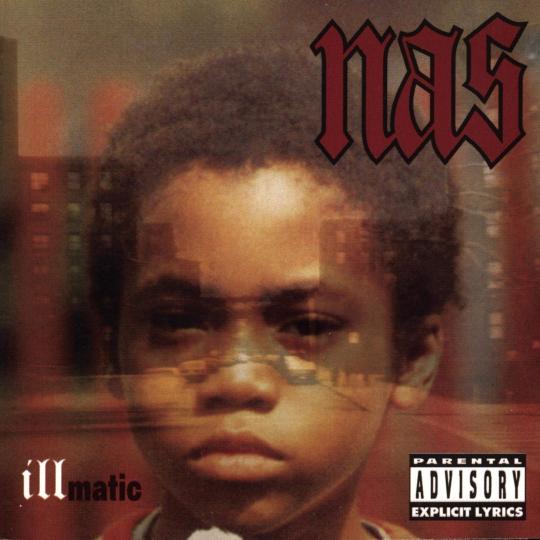
Imagine this; you start out your career as an MC and within a few short years, with the release of your debut album, you become one of the most important rappers on the planet and the album is not only talked about as the best rap album of all time, but it’s in the discussion for best album of all time, across any genre.
That is what happened to Nas in 1994 when he released the hardcore hip-hop masterpiece, Illmatic.
Showcasing rhythmic perfection and poetic lyrics from the young rapper paired with beats supplied by some of the best producers on the block such as DJ Premier, Q-Tip & Pete Rock, the album would wrestle the power away from the thriving west coast scene and signal the renaissance of the east coast, with the likes of Wu-Tang Clan & Mobb Deep following shortly after.
‘Halftime’ & ‘N.Y State Of Mind’ both showcase everything that is impactful about hip-hop and are consistently mentioned as two of the classics of the genre, alongside the ever-quotable ‘Life’s A Bitch’, the album would stun audiences upon its release, with many people fascinated with Nas’ multisyllabic rhymes and flawless delivery, but it was also the songs under the hood that keep Illmatic ticking along.
The nostalgic ‘Memory Lane (Sittin’ in da Park)’ showcases Nas’ poetic lyricism, mixing the styles of the old school and new school to create a haunting melody. ‘One Love’ is a storytelling marvel, composing of a series of letters to incarcerated friends, addressing unfaithful girlfriends, emotionally tortured parents and loyalty.
‘It Ain’t Hard To Tell’ wraps up the album up with a stylish, superior form of rap, the new sound of hip-hop was here and Nas will forever be one of the most important figures in the genre, largely thanks to the impact that Illmatic had and still has today.
-----------------------------------------------------------------------------------------------------------
Run The Jewels - Run The Jewels II (2014)

I could have honestly put any of the three releases by RTJ here. the prodigious duo of Killer Mike & El-P smashed onto the rap scene in mid-2013 with their acclaimed self-titled debut album but it’s with the release of RTJII that they found their true sound.
Militant, raucous and heavily beat-driven (thanks to the production by El-P) you would be forgiven for not being able to name a single album that exploded onto the hip-hop landscape quite like this, picking up many ‘album of year’ accolades in the process including Rolling Stone and Pitchfork.
The natural chemistry between the two artists shines throughout, both of which were at the apex of their prime at the time of recording the album, delivering a powerful mix of hard-nosed disses and sophisticated composition.
Coming in successively at track 2, 3 and 4 on the album ‘Oh My Darling Don’t Cry’, ‘Blockbuster Night, Pt. 1′ & ‘Close Your Eyes (And Count To Fuck)’ are three of the most aggressive and abrasive tracks in hip-hop history, the last of which includes the ever-warring Zack de la Rocha of Rage Against The Machine.
In ‘Lie, Cheat, Steal’ they created their anthem, a song that will forever define this era for the duo and with ‘All Due Respect’ & ‘Early’ they have the help of multiple collaborator BOOTS and pop-punk superstar Travis Scott to add to the variety of tracks on the album, the former being a synth-heavy showcase.
They were one of the first bands to utilize new VR technology, experimenting with a music video for the astonishing, post-apocalyptic track ‘Crown’ and they gave fans a light-hearted parody remix album named ‘Meow The Jewels’ featuring beats created entirely from cat sounds that was released free for fans.
-----------------------------------------------------------------------------------------------------------
GZA - Liquid Swords (1995)
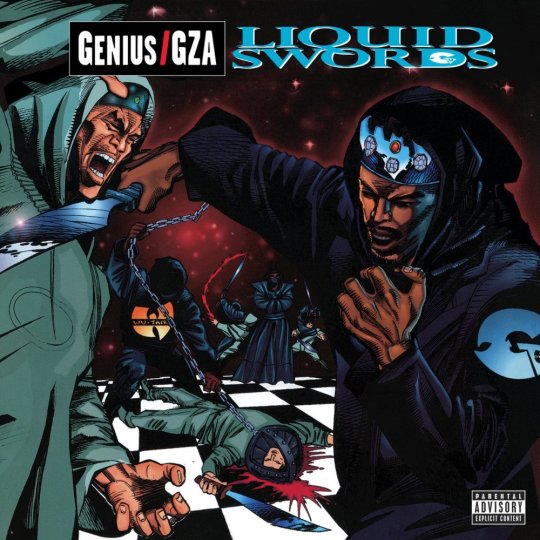
When I was younger, a friend I knew was talking to me about hip-hop, I had just discovered the Wu-Tang Clan and I was excitedly telling everyone I knew about ‘Enter The Wu-Tang’ and she told me that it paled in comparison to the solo album put out by GZA, a member of the influential clan.
I remember thinking that a solo member of the group could never create something as powerful as Wu-Tang’s debut release and I put off listening to it for weeks. To this day, I’ve not had the pleasure of experiencing an album for the first time like I did with Liquid Swords.
Heavily sampling the martial-arts cult classic ‘Shogun Assassin’, the dark atmosphere and outstanding storytelling has ensured that it’s only increased in popularity since it’s release almost 25 years ago, with many fans retrospectively proclaiming it the greatest hip-hop album of all time.
It’s a testament to Liquid Swords that the Wu-Tang Clan, one of the most well-known, influential groups in rap history featuring the collective talents of RZA, GZA, Ghostface Killah, Method Man, Raekwon & Ol’ Dirty Bastard amongst others, have never managed to create such a memorable and strangely beautiful album. It cements GZA as the band’s greatest pure lyricist.
Proof of its greatness is in the knowledge that this album flows together seamlessly, so much so that it’s hard to pick out individual tracks that stand out, so I won’t. Each track is as important to the feel and story of this magnificently crafted classic.
-----------------------------------------------------------------------------------------------------------
Kendrick Lamar - DAMN. (2017)

If you haven’t already heard, Kendrick Lamar is the new king of hip-hop.
Back in 2009, a supergroup formed under the name ‘Black Hippy’. The band would feature Schoolboy Q, Ab-Soul, Jay Rock and a young Kendrick Lamar. After gaining some attention early on in his career, he eventually outgrew the group and burst onto the west coast scene in late-2012 with his breakout ‘Good Kid, M.A.A.D City’.
‘To Pimp A Butterfly’ & ‘untitled unmastered’ would follow in 2015 and 2016 respectively, catapulting Kendrick to the very top of the rap game. But it was his 2017 masterpiece DAMN that would cement him as the top solo performer in hip-hop.
Featuring soul-baring, furious rhymes that are unrivaled by any modern rappers, the break-neck speed of ‘DNA’ would become the calling card for what would be the breakout moment for the young prodigy, the moment that the doubters finally had to stand up and take notice.
‘ELEMENT’, ‘PRIDE’ & ‘FEAR’ all showcase the swagger and drawl that has become synonymous with Kendrick’s style, but it’s the stand-out ‘FEEL’ that takes the album to the next level. The dynamic and sparse track is stripped down to only the essential beats, displaying Lamar’s evolving complexity in his material.
There is even room for some notable cameos on a few tracks, with Rihanna featuring on ‘LOYALTY’ and Zacari providing the hook for the excellent ‘LOVE’. U2 even manage to contribute to the album with Bono lending his voice to ‘XXX’.
Still only 31 years old and with a few classics already under his belt, the world awaits the next album from the young king.
-----------------------------------------------------------------------------------------------------------
A Tribe Called Quest - The Low End Theory (1991)

How can anyone talk about the greatest, without mentioning A Tribe Called Quest?
Initially praised as a quantum leap for rap, the Tribe’s second album The Low End Theory is to hip-hop what Thriller is to pop music or Discovery is to electronic music; forever synonymous with the genre and in the years since it’s release, is seen as a major milestone for the genre.
People's Instinctive Travels and the Paths of Rhythm, the debut album by the group, was ground-breaking in its own right. Giving audiences a glimpse into the sprawling, rhythmic sound that the band would go on to cultivate and along with the unique approach to the mic shown by Q-Tip, they released hit after hit starting with the classic ‘Can I Kick It?’ followed by ‘Luck Of Lucien’, ‘Rhythm’ and ‘Bonita Applebum’. They would follow on with their experimental, jazz-centric style with the second release only a year later.
The major difference between both albums comes down to two things; the emergence of Pfife Dawg and Q-Tip’s peerless production style.
A month after the release of People's Instinctive Travels and the Paths of Rhythm, group member Phife Dawg learned that he was diabetic and almost left the group. After speaking with fellow member Q-Tip, they agreed to increase his participation on their second album and it would lead to a completely new element to the sound that the band were evolving on The Low End Theory.
This is no more prevalent than on the excellent ‘Buggin’ Out’ and lead single ‘Check The Rhime’ and despite initial worries for its critical success, the release of the stand-out ‘Jazz (We’ve Got)’ followed by ‘Scenario’, which is widely considered to be the Tribe’s greatest track and the breakout moment for the career of the young Busta Rhymes.
It’s also the strength of the other songs on the album that resonates with audiences to this day, the Q-Tip led opener ‘Excursions’ sets the pace whilst the exceptional ‘Butter’, ‘Vibes And Stuff’ & ‘Verses Of The Abstract’ feature beats and rhymes that are so well assembled that they could lead any other album, past or present.
0 notes
Text
T. Creative Investigation - First Draft
Creative Investigation
For my creative investigation I will be focusing on the director Sergio Leonie and if he can be considered a true auteur and what this means. I will be applying film theory to my investigation and considering its relevance to Sergio Leone’s work, contextually and critically. I will be using various sources to support my hypothesis and arguments in relation to my three focal films which are; The Good The Bad And The Ugly (1966), Once Upon a Time in The West (1968) and Once Upon a Time In America (1984).
Hypothesis: Can Sergio Leone be considered an auteur?
Sub-topics:
-To what extent does Sergio Leone owe his style and legacy in A Fistful of Dollars to Yojimbo, and what did the subsequent legal battle prove?
-What stylistic elements of the spaghetti western can be considered original of Sergio Leone?
-How has Sergio Leone’s style changed from work pre-spaghetti westerns working as a collaborative assistant and second unit director, to working directing westerns, post western drama’s and his satirical style.
1. To what extent does Sergio Leone owe his style and legacy in A Fistful of Dollars to Yojimbo, and what did the subsequent legal battle prove?
Paul Sellors has previously claimed that authorship is “an issue of intention” and it has been documented (source 1) that Leone carefully selected his co-writers even though he put a minimal level of importance on dialogue. This shows that there is a debate over who can truly be considered the true author of Leone’s films where he is not the sole writer.
As part of my study of Sergio Leone focusing on authorship, I have analysed the films The good, the Bad and The Ugly, Once Upon a Time in the West and Once Upon a time in America in order to determine whether Leone can be considered to be an ‘auteur’ as well as the ‘true author’ of his films.
Pauline Kael previously stated that Akira Kurosawa’s Yojimbo (1961) “could exploit Western conventions while debunking its morality” and also that this, “was the key to Leone’s success and, to some degree, to that of the spaghetti Western genre as a whole.” From what Pauline Kael has written we can see that Yojimbo was a Japanese take on the westerns that had stereotypical storylines and similar themes. Kurosawa took these conventions and subverted them somewhat, to create ‘Yojimbo’, Kursawa’s take on a ‘traditional’ Japanese film. This then became a massive inspiration for Sergio Leone’s generation of filmmakers, who then subverted the values presented in Yojimbo ironically, to create their own westerns with distinct storylines and protagonists who had their own unique moral codes.
The legal battle that was held over the rights for ‘A Fistful of dollars’ makes a strong case against Sergio Leone being a true Auteur as his film was based on another directors creative vision. Kurosawa notoriously made a statement on the likeness of ‘A Fistful of dollars’ to his own film, saying that it was indeed “a fine movie, but it was MY movie.” The amount Kurosawa received from the resulting lawsuit is debated, but it is known that Leone settled out of court which makes a clear statement in itself, showing that Leone acknowledged that at least some of the credit for ‘his’ film is owed to Kurosawa. This means that even on a legal basis, Leone cannot be credited for the full authorship of his own film, which makes a strong argument against Leone being an auteur. However, originality isn’t technically one of the three parameters of an auteur, although the parameter it most closely relates to ‘personal style’ is the one aspect of ‘A fistful of dollars’ that is taken most directly, (or borrowed) from Yojimbo.
A Fistful Of Dollars

Yojimbo

A Fistful Of Dollars
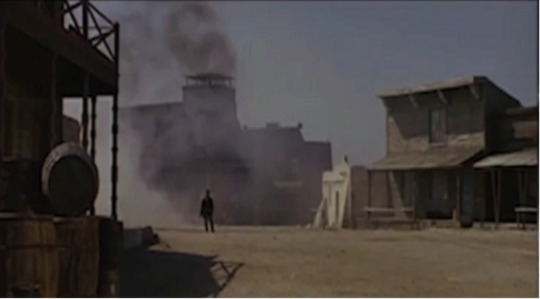
Yojimbo
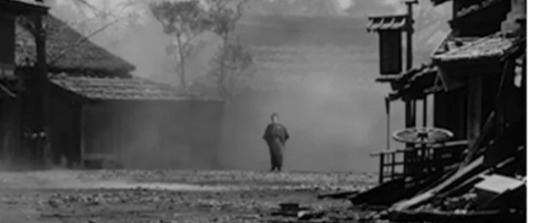
The images above show the similarity between Yojimbo and A fistful of dollars, and it is understandable to see where it can easily be debated whether Leone is indeed an auteur or not.
When Francois Truffaut's wrote the article "A Certain Tendency of the French Cinema" which was the bedrock on which auteur theory was founded, it is not originality in concept or plot was his greatest concern, rather it was if a film was wholly original and the quality of the directors work was consistent and of a high standard. However he does reference ‘talkies’ as a plagiarism of American cinema on the part of the French filmmakers at the time; talkies were the first short films to feature dialogue, hence the name. Truffaut uses the phrase "Tradition of Quality", which he used to apply to any filmmaker that could be considered an auteur, must have, as it is an indication of personal style, technical competence and inner meaning being present in all of their work, showing a consistent use of these parameters. Looking at Leone’s work as a whole, it is evident that his filmography is all of a high standard, and he does have a ‘tradition of quality’. Although Leone borrowed stylistic elements from Yojimbo, I do not think he borrowed the ‘style’ and Leone’s style which is present throughout all of his films, is not based upon and does not owe any massive debt to Kurosawa. On the other hand, whilst not being a direct plagiarism, I think having signature stylistic elements from ‘Yojimbo’ present in ‘A Fistful of Dollars’ as some of the key stylistic features of the film, does make the question of whether Leone has met Sarris’ criteria with PERSONAL style, relevant. In spite of the question, ‘Can Leone truly be considered an auteur when analysing ‘A Fistful of Dollars’, I think that Leone does have a “tradition of quality” throughout his films, and Sarris’ model of auteur theory can be applied to his work as a whole.
2. What stylistic elements of the spaghetti western can be considered original of Sergio Leone?
Some would consider Sergio Leone’s ‘Dollars’ Trilogy and ‘Once Upon A Time in the west’ the only true ‘Spaghetti Westerns’, however it can easily be debated that the wave of copy-cat westerns that came after the success of the final film in the trilogy, ‘The Good, The Bad and The Ugly’ can claim to and also be considered a spaghetti western in their own rights. Whilst not being completely original in style or concept, they are still part of the trend which changed western and specifically American culture from looking to the moon, to looking to the past. It is also important to give these look-alike films credit for Leone’s later satirical westerns, which parodied the films, which had started to become parodies of themselves when copying Leonie’s work. Without which his final ‘westerns’ would most likely not exist, which not only signified the end of Leone creating new westerns as part of his cannon, it also showed the extent that westerns had been stretched to and overdone in order to make a profit and cash in on Leone’s success. Therefore Leone put the western to bed not only for himself, but also for a whole culture.
My 5th source states “Spaghetti westerns copied the look and feel of the Dollar Trilogy. Often filmed on the very locations in Spain used by Leone, these westerns offered desolate landscapes that created dark moods.” This shows that in order to achieve similar shots to Leone, some filmmakers went to the extreme of going to the place where they were originally shot. This is probably the most tangible element of each film from this time period of the mid-sixties to mid-seventies which has been classified as a ‘spaghetti western’, the setting. Sarris’ three parameters of an auteur can be applied to the filmmakers that jumped on the bandwagon of the spaghetti western, who’s personal style, or lack thereof is derived from using (or copying) signature elements of Leones westerns.
Daniel chandler states, “conventional definitions of genres tend to be based on the notion that they constitute particular conventions of content (such as themes or settings and/or form (including structure and style)”. This supports the idea that none of what is considered typical of Sergio Leone’s westerns can be fully owed to him, and rather the genre is the true author, and as much as the director tries to subvert or stray from the typical conventions of a ‘western’, all of the conventions that dictate various aspects of the film, such as setting, plot and character types, are already set by typical film conventions of that genre. In ‘creating’ the sub-genre of ‘Spaghetti western’ Leone laid out certain conventions in the dollars trilogy, which were then arguably, public property to imitate or mimic. Jonathan Culler argues that the conventions of genre are in place to establish a “contract between creator and reader so as to make certain expectations operative, allowing compliance and deviation from the accepted modes of intelligibility”. The point Culler is making is that, whilst conventions exist they can be deviated from enough to create an original concept. This applies to the directors that took ‘heavy inspiration’ from Leone’s work, but generally isn’t because the lion’s share of westerns made in the wake of Sergio Leone’s, were never intended to be original or deviate from the conventions of Leone’s films, they were simply there to emulate them all the way to the bank.
An interesting point to take into account when considering spaghetti westerns, is that a spaghetti western is generally classified as a western made by an Italian director within Europe. So spaghetti western is just a label applied to a western film because the director being Italian, or the film being shot In Europe, is irrelevant
3. How has Sergio Leone’s style changed throughout his career?
Leone’s full directorial debut, ‘The Colossus of Rhodes’ released in 1961, follows the Roman Empire’s rise and can be classed as a ‘stereotypical’ 1960’s period-action-drama film. The next film Leone released was ‘A fistful of dollars’, which signalled the beginning of his breakthrough into the mainstream, as by the time the last film in this ‘man with no name trilogy was released’ ‘A Fistful of Dollars’ was becoming a hit film in America. After the dollars trilogy, Leone moved onto ‘Once Upon a time in the west’, which saw Leone starting to use a few ‘classic American’ locations, with the main filming locations comprising mainly of European locations.
In ‘Once Upon A Time in The West’ Leone began changing the ‘usual’ film conventions he applied to his films. It stars Henry Fonda as the main protagonist, and Claudia Cardinale as the main ‘hero’ of the film, but not the ‘star’. This showed a shift in Leone’s work, from featuring the protagonist being an ‘anti-hero’, as Clint Eastwood is in the man with no name trilogy, to being an outright villain. Some would say that the socio-political context of the 1960’s began changing and influencing Leone’s films, and the messages and values behind them. ‘Once Upon a time in the west’ was created during the second wave of feminism during the 1960’s, and some would argue that Leone empathised with this movement. This could be the reason for him featuring Claudia Cardinale as the female lead Hero, playing a strong empowered character and being more representative of the female gender than other pictures at the time. Laura Mulvey wrote about feminist theory in her own book seven years after this picture was released, and one of her arguments that outlined the way females were objectified and demeaned in films in a more covert manor was via the ‘Male Gaze’. Leone took this convention and made it completely redundant when the character of Cheyenne meets Jill. Cheyenne is looking for redemption and befriends Jill, misunderstanding his intentions at first Jill says, “If you want to, you can lay me over the table and amuse yourself, and even call in your men. Well, no woman ever died from that. When you're finished, all I'll need will be a tub of boiling water and I'll be exactly what I was before - with just another filthy memory!”. This scene shows the strength and competence of Jill, whilst at the same time removing any sexual connotations from the relationship between the two characters and presents Jill and Cheyenne as equals, rather than presenting Jill solely as a sexually objectified character just because she is a woman. It also breaks the stereotype and Jill’s assumption of Cheyenne’s intentions, and shows that not every male is derelict of moral standards and conscience, and that all males are obsessed with sex, as Cheyenne declines with a sigh and the comment, “You make good coffee, at least?”. This reinforces both characters likeableness with the audience, Cheyenne’s character becomes more well like because he turns down Jill’s ‘offer’ because of his moral standards, and Jill is shown as a strong female lead that breaks traditional conventions of a female in a western.

Primary Research Texts:
Filmography
·Item 1: Leone, Sergio, 1966, The Good The Bad and The Ugly, Produzioni Europee Associate (PEA) (produced for) (as PEA - Produzioni Europee Associati - Rome)
This is the final film in Leones ‘Dollars Trilogy’and focuses on the quest for buried gold in the old west by three suspect individuals. This was the film that ‘broke’ the film series in America and it was soon after this films release that these films reached massive critical acclaim and financial success in America, and changed western culture permanently.
·Item 2 : Leone, Sergio, 1968, Once Upon a Time In The West, Rafran Cinematografica (as A Rafran-San Marco Production)
·Finanzia San Marco (as A Rafran-San Marco Production)
·Paramount Pictures (copyright holder) (as Paramount Pictures Corporation)
This is another of Leone’s westerns which unconventionally has a female protagonist, which is something Leone consciously did, which is interesting as contextually, this film was released during the second wave of feminism, and it is interesting to consider Leone as a feminist.
Item 3: Leone, Sergio, 1984, Once Upon A Time In America, Ladd Company, TheEmbassy International PicturesProducers Sales Organization (PSO) Rafran Cinematografica (uncredited)St. Petersburg Clearwater Film Commission
This film stands out when looking at Leone’s films as a body of work, it is the longest of his films, and it is also not a western. Leone also used a host of A-list stars in this film, which differs from his earlier work where he had to work with relative unknowns.
Secondary Research Texts:
1. Lannone, P, (2014), The interview, Sight and sound Magazine
2. O'Neill, P, (2009), How The West was Written, The Guardian
3. Riet, P, (2017), Sergio Leone interview on Clint Eastwood and the Dollars Trilogy 1977
4. Aquila, R, (2015), A Fistful of Dollars: Spaghetti Westerns and Changing Times, The Sagebrush Trail
5. Mcclain, W, (2010), Western, Go Home! Sergio Leone and the “Death of the Western” in American Film Criticism, University of Illinois Press on behalf of the University Film & Video Association
6. Newman, K, (2000), Once Upon A Time in the West Review, Empire Magazine Online
7. Naughton. J, (2000), The EMPIRE ESSAY: The Good Bad And The Ugly Review, Empire Magazine Online
8. Smith, A, (2000), Once Upon A Time In America Review, Empire Magazine Online
9. Newman, K, (2013), The Good Bad And The Ugly Review, Empire Magazine Online
10. Macnab, G, (2011), Quentin Tarantino - The good, the bad and the movie geek, The Independent
11. Mitchell, E, (2003), FILM; Sergio Leone’s Jazz Western, The New York Times
12. (2000), A Fistful of Dollars Review, Empire Magazine Online
0 notes